Ann Arbor, Michigan
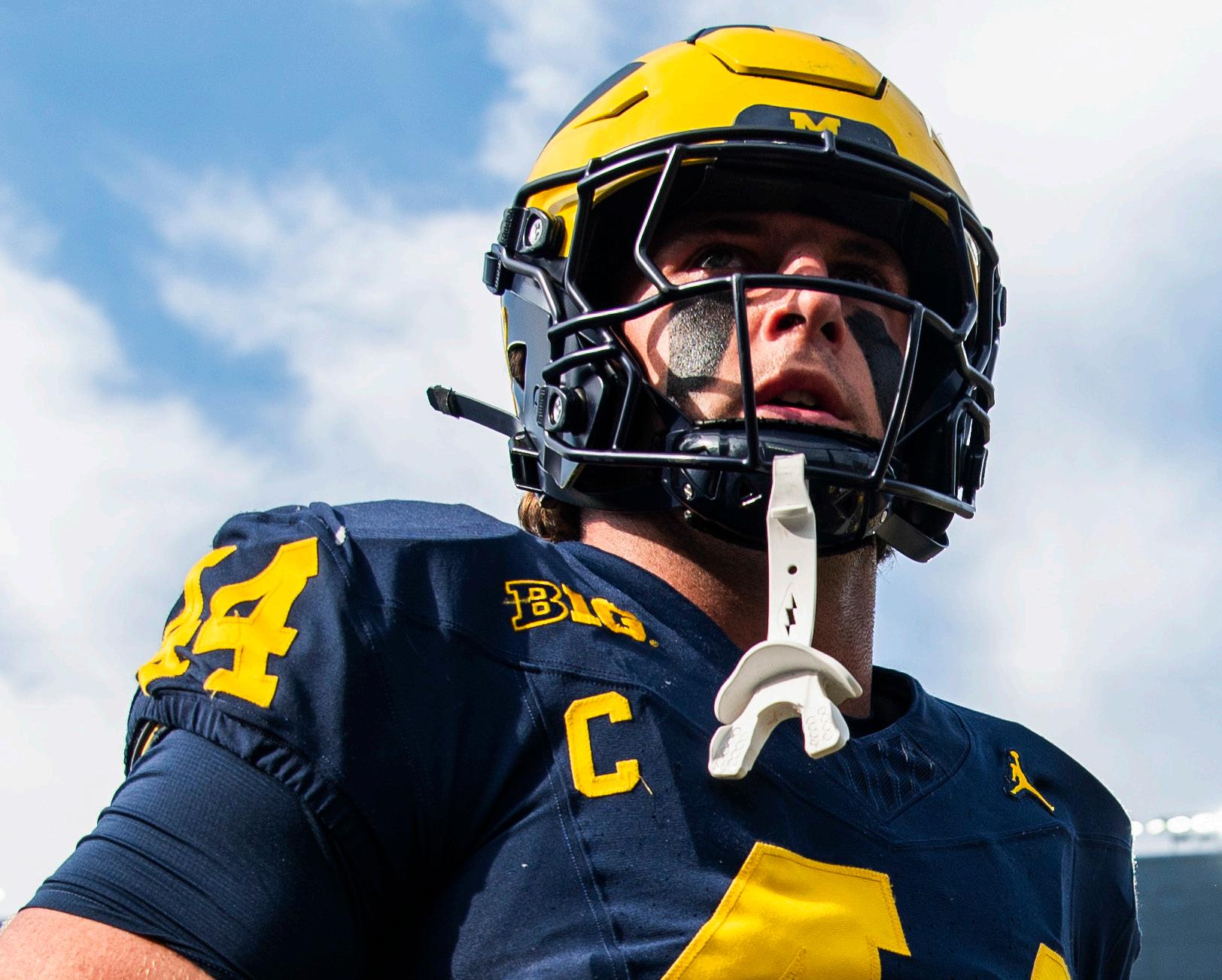
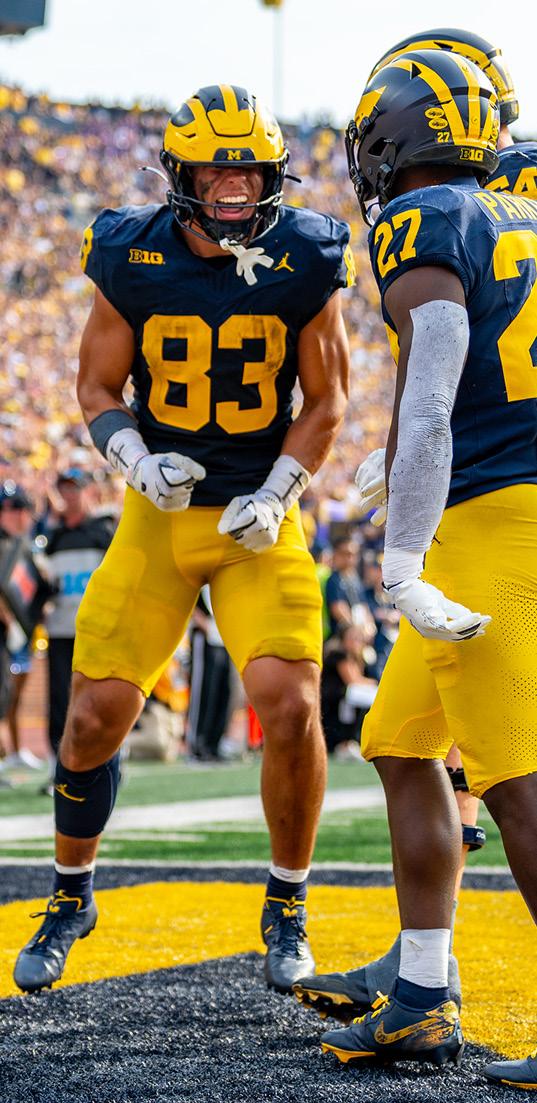


Ann Arbor, Michigan



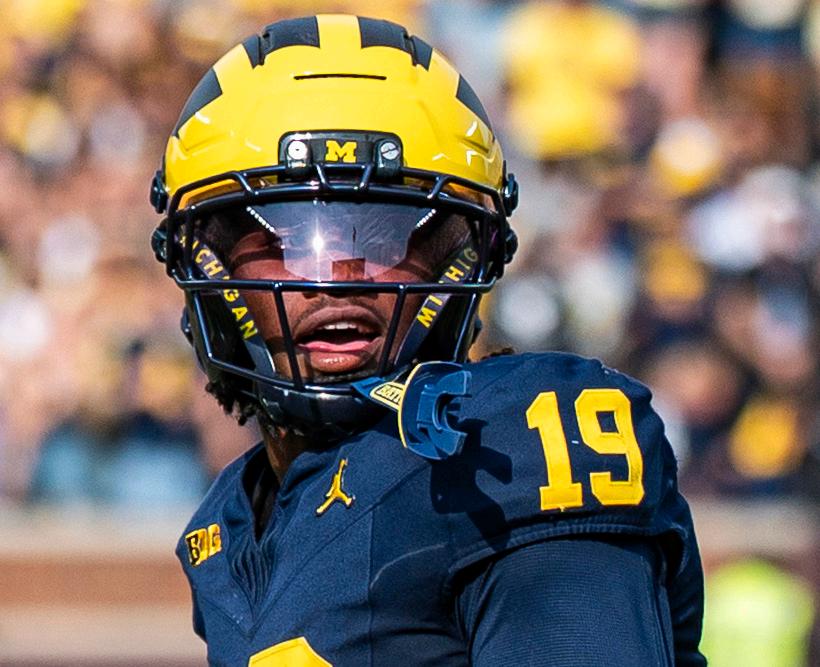
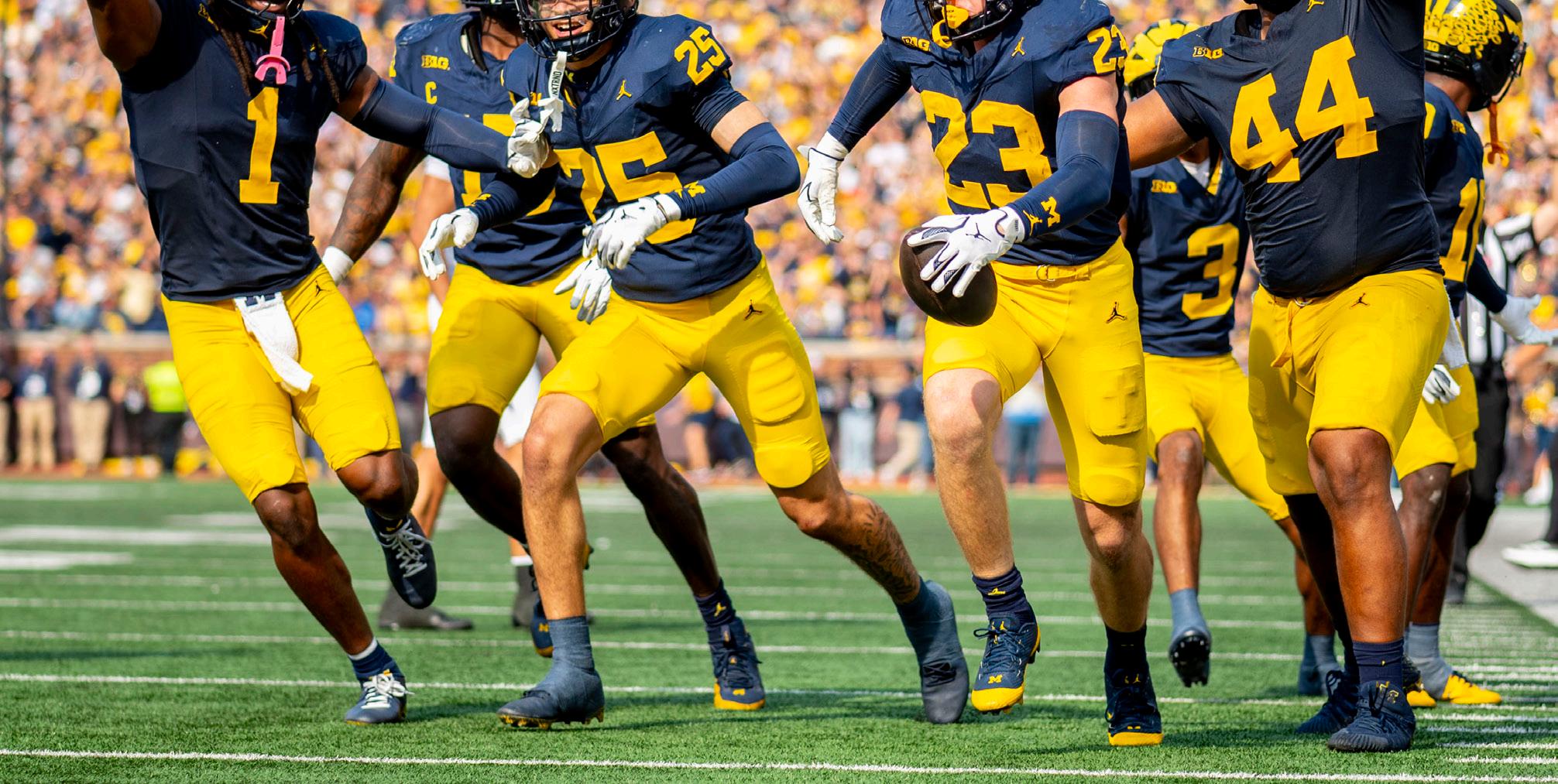
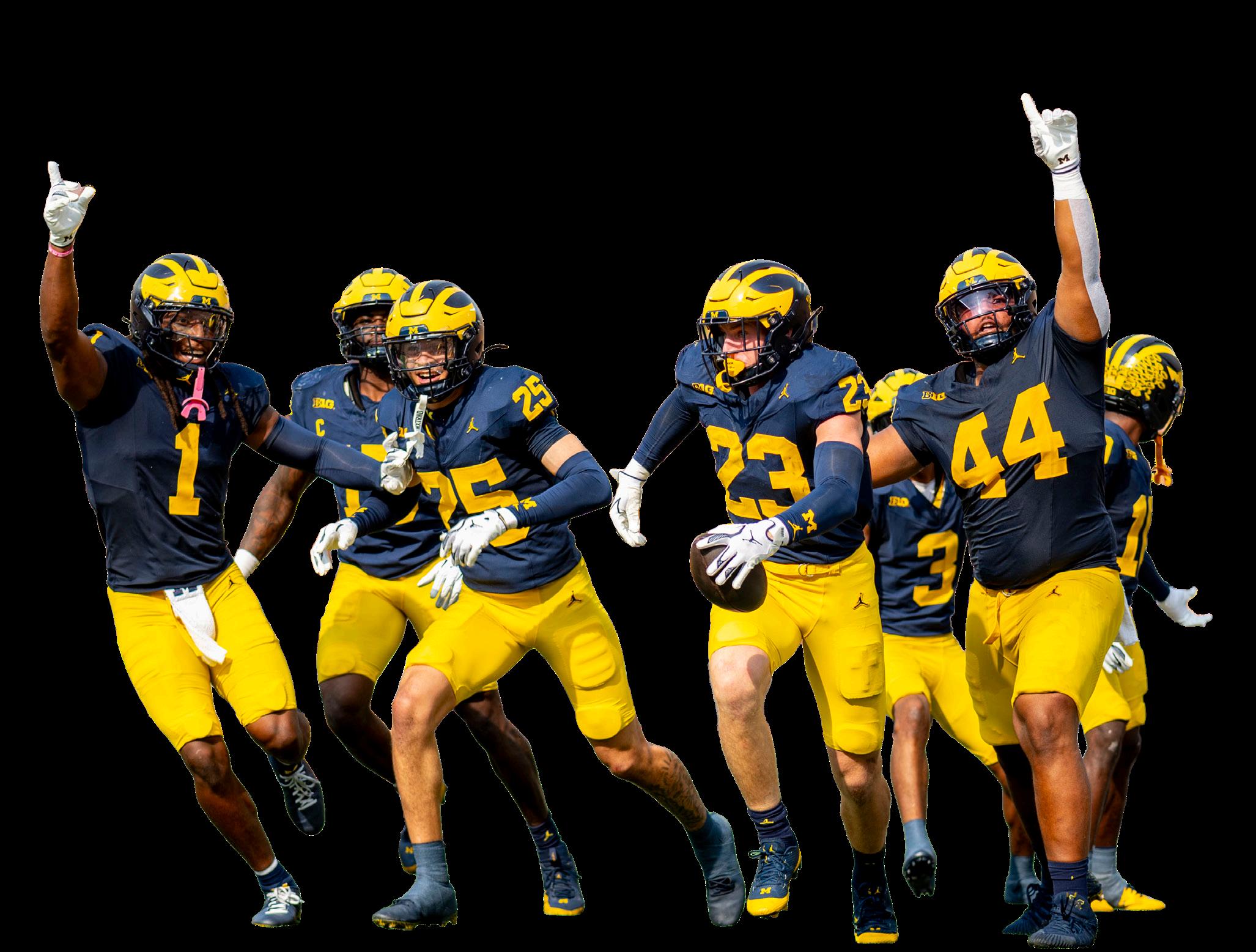

TALINA LEVINE Daily Sports Editor
he majority of the Michigan football team’s game against Washington was a defensive showdown.
While both the Wolverines and Huskies’ offenses managed to make significant gains down the field on multiple occasions, more often than not, they fell short of their ultimate goal: the endzone.
But in the defensive battle, it was Michigan’s (5-2 overall, 3-1 Big Ten) unit that came out on top, snuffing out Washington’s (5-2, 2-2) offensive fire by stopping the run game and forcing turnovers en route to the 24-7 victory.
“Playing hard, that’s really what it came down to,” senior
linebacker Jimmy Rolder said. “Playing selfless and just playing together.”
At the start of the contest, both offenses were stuck in gridlock. Even with the Huskies having the third-ranked offense in the conference, they struggled to make their way home for a touchdown in the face of the Wolverines’ stifling defense. It wasn’t until the end of the first quarter that Michigan broke through the stalemate, notching a touchdown for a small cushion and an early lead.
The majority of the second quarter mirrored the first, with each defensive unit taking turns smothering the respective offensive attack. But with just 40 seconds left in the half, running back Jonah Coleman snuck
through the gap up the middle to notch Washington’s first points of the contest, evening the score.
Amid the offensive stagnancy that marred the first half, the Wolverines’ defense reared its head time and time again. Whether through a broken up pass, open field tackle or tackle for loss, it quickly became clear that Michigan’s defensive unit was going to be the difference maker.
With the game tied, the pressure amped up for both teams. Luckily for the Wolverines, their defensive unit was built to handle it.
Michigan’s first two drives of the third quarter fell short, with the first ending in a turnover on downs and the second resulting in a punt. It seemed as though the tune of the third quarter was
going to be similar to that of the first.
With 1:32 remaining in the third quarter, quarterback Demond Williams Jr. rattled off another pass to his right. But instead of hitting his intended target, sophomore linebacker Cole Sullivan jumped ahead of the route, snagging the ball for an interception and changing the tune of the game.
Not only did Sullivan stop the Huskies’ momentum, he gave the Wolverines’ offense a second chance deep within Huskies territory. And on the first play, sophomore running back Jordan Marshall ran it home to retake the lead, 14-7.
As it turns out, though, Michigan’s defense wasn’t done yet.
With just 29 seconds left in the third quarter, the pocket once again started to collapse on Williams. Desperately searching the field, Williams’ eyes locked on Washington tight end Decker DeGraaf. Firing the ball toward him, Williams was once again left high and dry as the pass sailed straight into the waiting arms of Rolder.
“You got to catch the ones that get they throw to you,” Rolder said. “Just huge momentum shift. You just felt the energy on the sideline and (it) just propelled the offense out there. They went out there driving the ball down.”
It was these interceptions that reignited the Wolverines’ offensive fire. Similar to what happened after Sullivan’s
interception, Michigan’s offense steamrolled its way into the end zone for another touchdown and a definitive lead. By the time the clock ran out, Michigan’s defense had done more than just hold its own — it had created the key moments. With seven tackles for loss, two sacks and three interceptions, the Wolverines’ defensive unit formed a wall that Washington simply couldn’t break through. When Michigan’s offense found its footing late, it was its defense that set the tone. In the game defined by resistance, the Wolverines’ defense proved immovable, and that decided the victory.
Grace Lahti/DAILY
Alyssa Mulligan/DAILY Design by Annabelle Ye






Thousands attend ‘No Kings’ protests in Ypsilanti and Ann Arbor
“We don’t do kings, we don’t do fascism. This is America — we have a constitution.”
KAYLA LUGO Daily Staff Reporter
More than 3,000 people gathered at Riverside Park in Ypsilanti Saturday afternoon to attend a “No Kings” protest led by Ann Arbor Indivisible and Ypsilanti Indivisible, two chapters of a nationwide prodemocracy organization seeking to elect progressive candidates. Protesters marched around the park while passing cars honked in support as they passed by. More than 2,000 protests were held across the country Saturday in protest of President Donald Trump’s administration.
The rally in Ypsilanti was the second “No Kings” protest in the area that day — Ann Arbor Indivisible also hosted a rally at Veterans Memorial Park Saturday morning. In an interview with The Michigan Daily, Gus Teschke, a member of Ann Arbor Indivisible’s steering committee, said the current movement to challenge Trump’s administration draws inspiration from the civil rights movement.
“We are forming a huge movement that can challenge him, like the old civil rights movement in the South,” Teschke said. “They were big. They had a
strategy. They were persistent and they were nonviolent. They took on an entrenched, violent, racist government, and they beat them nonviolently. And we can do the same thing to Trump.”
In a speech before the march, Washtenaw County Commissioner Yousef Rabhi said the day of protests across the country had the opportunity to unite people from different political backgrounds.
“There may be people here who are Republicans or Independents or Green Party or Socialists or Democrats, but we’re all here today as one unit to say, ‘we resist, we fight back,’” Rabhi said. “This is America. We don’t do kings, we don’t do fascism. This is America — we have a constitution.”
Chants of “This is what democracy looks like” rang through the streets as protesters held signs with messages including “Protect the People, Not the Rich” and “We have a Constitution not a king.”
In an interview with The Daily, Social Work student Aaliyah Richards said she felt the protest gave voice to people who are often unheard on campus and across Michigan.
“I think, for me, it highlights the fact that there are people in Michigan, there are people
on campuses, that are not being heard, regardless of how much we suggest that they are,” Richards said. “Allowing space for something like this is important. And I think it ties to the fact that collectively, we are hoping for a change, we are hoping that our voices will be heard.”
During his pre-march speech, Rabhi also reflected on the democratic oath he and other officials — including Commissioner Annie Somerville, D-District 6, and Superior Township Trustee Dana Greene Jr. — took for their constituents.
“When I took my oath, when (Somerville) took her oath, when (Greene Jr.) took his, we pledged an oath to the Constitution of our state and of our country,” Rabhi said. “We do not pledge to any leader, to anybody but you, the people. That’s how democracy is supposed to work. We work for you, the people, and at the end of the day, the people united will never be defeated.”
Teschke said he believes the Trump administration’s policies are silencing voters and targeting immigrants. In the past four months, Trump has suggested or ordered sending federal intervention to nearly a dozen cities. This week, Trump asked the Supreme Court to grant him permission to send
the National Guard to Chicago, overturning lower court orders that block the effort. He has also initiated an aggressive plan for mass deportations, including expanding the enforcement power of Immigration and Customs Enforcement and targeting those with legal status.
“(Trump is) kidnapping immigrants off the streets,” Teschke said. “He’s got troops. He sent troops into cities that are peaceful. He is trying to silence voters’ voices, and he’s defying the courts. This has many people very upset, and they’re looking for a way to fight back. And that’s Ann Arbor. The Indivisible movement is one way to fight back.”
Richards said she attended the protest to use her voice and privilege to support those who cannot for fear of being detained.
“We’ve always been the melting pot, and I’m here because I can be loud,” Richards said. “I can scream, ‘Fuck Trump, fuck ICE,’ and I don’t have to worry about being detained the way that many others do, at least not right now. I’m going to use my voice, and I’m going to tell you that we need to show up and amplify those that cannot do that for themselves.”
CONTINUED AT MICHIGANDAILY.COM
The University and Los Alamos National Laboratory are planning to build a $1.25 billion facility in Ypsilanti
GLENN HEDIN Daily Staff Reporter
Update 10/17: This article has been updated to include a statistic on the facility’s proposed size provided by the University.
The University of Michigan, in partnership with the Los Alamos National Laboratory, is planning to build a $1.25 billion data center in Ypsilanti, which has received pushback from local residents over the potential environmental impact it would have on the surrounding area. Although construction was initially scheduled to begin in 2026, the University has delayed the beginning of construction to 2027. Since the facility is intended for research purposes and not as infrastructure for website data or cloud storage, the University has requested that the facility under construction be referred to as a high-performance computing center instead of a data center. The University has stated the building will not function like a commercial data center store that hosts privatesector platforms like social media, the cloud or e-commerce, but rather a computing facility
built for research focused on AI, energy and national security.
In an interview with The Michigan Daily, Samantha Stewart, Ypsilanti resident and Stop The Data Center organizer, said she and other activists oppose the center due to its water and electricity consumption, which typically doubles local power costs for residents living around a data center.
“There’s clear data that people who live close to data centers pay, usually, close to 200% more for their electricity bill,” Stewart said. “So, I don’t want to fund this data center. DTE (Energy) bills are high enough as it is already. Data centers use a ton of water, and they don’t create jobs. It’s just a warehouse full of computers that’s really loud and bad for the environment.”
The University did not respond to request for comment in time for publication, but has issued public statements in the past to alleviate the residents’ concerns. In an email to The Daily, University spokesperson Kay Jarvis also stated the facility would have a footprint one-tenth the size of a typical data center, leading to a reduced energy demand. In a public statement, Engineering professor Steven Ceccio, who has been involved
with the project since the beginning, stated that the building will be fully electric and will not generate excessive noise.
“The building will be fully electric and designed to operate with minimal impact on the surrounding neighbors,” Ceccio said. “The facility will not result in excessive noise, vibrations or fumes and on-site generators will be used only for emergencies and limited testing, covering no more than 20% of the facility’s total energy load.”
Activists who spoke to The Daily said they believe the University was lying when it made these claims. Stewart said the backup generators used in data centers typically use diesel or natural gas, not renewable energy.
“They can say whatever they want and we can’t fact check them, and they know that,” Stewart said. “There are some clear and outright lies, like saying that it’s all going to be electric. Part of the function of data centers is they must have backup generators, which are, by definition, going to be diesel and not electric.”
Activists also oppose this construction project due to the potential for its research to be
Stanford Lipsey Student Publications Building 420 Maynard St. Ann Arbor, MI 48109-1327 734-418-4115 www.michigandaily.com
ZHANE YAMIN and MARY COREY Co-Editors in Chief eic@michigandaily.com
ELLA THOMPSON Business Manager business@michigandaily.com
NEWS TIPS tipline@michigandaily.com
LETTERS TO THE EDITOR tothedaily@michigandaily.com
EDITORIAL PAGE opinion@michigandaily.com
PHOTOGRAPHY SECTION photo@michigandaily.com
NEWSROOM news@michigandaily.com CORRECTIONS corrections@michigandaily.com
ARTS SECTION arts@michigandaily.com
SPORTS SECTION sports@michigandaily.com
ADVERTISING wmg-contact@umich.edu
Editorial Staff
CECILIA LEDEZMA Joshua Mitnick ’92, ’95 Managing Editor cledezma@umich.edu
FIONA LACROIX Digital Managing Editor flacroix@umich.edu
used for the development of nuclear weapons by Los Alamos, which first developed the atomic bomb in 1945 during World War II, and continues to work on nuclear weapons.
In an interview with The Daily, Rackham student Nathan Kim said he worries the center could be used by Los Alamos in their production of plutonium pits, a key component of nuclear weapons.
“They need high-performance computing facilities in order to ensure the pits that are developed can detonate symmetrically, that they’re going to detonate on time, that they’re not going to be thrown off course by antiballistic measures,” Kim said.
“All those kinds of simulations, I think, are exactly why the University and Los Alamos are partnering to build this large supercomputer basically in our backyard.”
The larger part of the center will be a facility for federal, classified research. On their website, the University claims the facility will not manufacture nuclear weapons but will focus on national security challenges such as “nuclear and other emerging threats.”
JONATHAN WUCHTER and ZACH EDWARDS Managing Sports Editors sports@michigandaily.com
Senior Sports Editors: Annabelle Ye, Alina Levine, Niyatee Jain, Jordan Klein, Graham Barker, Sam Gibson
CAMILLE NAGY and OLIVIA TARLING Managing Arts Editors arts@michigandaily.com
Senior Arts Editors: Nickolas Holcomb, Ben Luu, Sarah Patterson, Campbell Johns, Cora Rolfes, Morgan Sieradski
GEORGIA MCKAY and HOLLY BURKHART Managing Photo Editors photo@michigandaily.com
Senior Photo Editors: Emily Alberts, Alyssa Mulligan, Grace Lahti, Josh Sinha, Meleck Eldahshoury
ANANYA GERA Managing Statement Editor statement@michigandaily.com
Editors: Graciela Batlle Cestero, Irena Tutunari, Aya Fayad ALENA MIKLOSOVIC and BRENDAN DOWNEY
Copy Editors copydesk@michigandaily.com
Senior Copy Editors: Josue Mata, Tomilade Akinyelu, Tim Kulawiak, Jane Kim, Ellie Crespo, Lily Cutler, Cristina Frangulian, Elizabeth Harrington
AHTZIRI PASILLAS-RIQUELME and MAXIMILIAN THOMPSON Managing Video Editors video@michigandaily.com
Senior Video Editors: Kimberly Dennis, Andrew Herman, Michael Park
AVA CHATLOSH and MEGAN GYDESEN Managing Podcast Editors podeditors@michigandaily.com
Senior Podcast Editor: Quinn Murphy, Matt Popp, Sasha Kalvert
MILES ANDERSON and DANIEL BERNSTEIN Managing Audience Engagement Editors socialmedia@michigandaily.com
Senior Audience Engagement Editors: Dayoung Kim, Lauren Kupelian, Kaelyn Sourya, Daniel Lee, Quinn Murphy, Madison Hammond, Sophia Barczak, Lucy Miller, Isbely Par SARA WONG and AYA SHARABI Michigan in Color Managing Editors michiganincolor@michigandaily.com
SAYSHA MAHADEVAN and EMMA SULAIMAN Culture, Training, and Inclusion Co-Chairs accessandinclusion@michigandaily.com
ANNA MCLEAN and DANIEL JOHNSON Managing Focal Point Editors lehrbaum@umich.edu, reval@umich.edu
Senior
Business Staff
OLIVIA VALERY Marketing Manager
“Make no mistake, in five years, we would all regret this deal at Michigan.”

programs across platforms nationwide.
The University of Michigan’s Board of Regents met Thursday afternoon on the U-M Flint campus to discuss campus cybersecurity and a potential financial deal with the Big Ten Conference, as well as to pass an amendment reinstating the Office of Student Conflict Resolution’s appeals board.
Interim University President Domenico Grasso opened the meeting, speaking on U-M Flint’s increased enrollment and continued growth as an institution of higher education.
“It’s gratifying to know that (U-M) Flint is making a critical difference in people’s lives, which in turn benefits the community and beyond,” Grasso said. “Congratulations to the enrollment management team and everyone who contributes to making (U-M) Flint an attractive and life-changing destination for students.”
Grasso continued, detailing the University’s Look to Michigan campaign, a media and fundraising initiative that aims to showcase the University’s
“We want the nation to look to Michigan as a beacon of hope,” Grasso said. “We are working to lead our fellow universities in reaffirming public trust in higher education. And we have a powerful story to tell.”
Khalid Malik, the U-M Flint College of Innovation and Technology’s director of cybersecurity, then gave a presentation on the Secure Modeling and Intelligent Learning in Engineering Systems lab — a way to incorporate artificial intelligence into health diagnostics. Malik described the SMILE project as an example of U-M Flint’s innovation and said he hopes to see the institution develop a more complex relationship with AI across medical disciplines.
“I dream of seeing an overhaul of cybersecurity curriculum, one that embraces generative AI without using it as a crutch,” Malik said. “Advances in Michigan cyber-readiness and media forensic centers are on the horizon and place where AI and neurological and cardiovascular research go hand in hand. All of that is possible. We can make it happen.”
Regent Jordan Acker (D) expressed discontent with the Big Ten’s consideration of acquiring a long-term share of conference revenue in return for an infusion of cash from equity. The deal would provide the Big Ten with 10% of future media revenue from member institutions for the next 21 years in exchange for $2 billion distributed among their athletic departments. He said increasing Big Ten expenses from athletic spending, as well as the financial burden on taxpayers and University alumni, avoids addressing the root cause of the University’s financial situation.
“Make no mistake, in five years, we would all regret this deal at Michigan,” Acker said. “Enough is enough. You can’t borrow your way out of a spending problem, and until these soaring expenses are addressed, throwing short term problems is akin to opening another credit card.”
Regent Mark Bernstein (D) said he agreed, characterizing the deal as irresponsible and careless.
CONTINUED AT MICHIGANDAILY.COM
AADL announces plans to acquire the Ann Arbor Observer
The monthly news magazine will remain editorially independent from the library
In September, the Ann Arbor District Library announced plans to acquire the Ann Arbor Observer, a monthly news magazine serving the Ann Arbor community since 1976. The acquisition is subject to the finalization of terms of the purchase agreement between the AADL and Patricia Garcia and John Hilton, co-owners of the Observer. After 40 years of co-ownership of the publication, Garcia and Hilton plan to retire at the end of 2025.
In an interview with The Michigan Daily, Garcia said the acquisition process started when she and Hilton attended the AADL’s exhibit chronicling the Observer’s work as part of the city’s bicentennial celebration in December 2024. During the exhibit, Garcia said they spoke to AADL archivist Andrew MacLaren, who later connected the Observer’s co-owners with AADL Director Eli Neiburger.
“We were at the point in our lives, although very grateful for having been stewards of the Observer for so many years, (where) it was time to figure out our succession plan,” Garcia said. “We feel that it’s important for the community to have an independent publication, and we did not want to sell it to anybody without putting a lot of thought into the stewardship in perpetuity. It’s also very important for the editorial content to remain completely independent, and the library has agreed to that.”
In an interview with The Daily, Neiburger said the library’s goal is to ensure public ownership of the Observer so it can continue as a free monthly publication.
“If this deal completes, my expectation is that I would see the Observer when it arrives in my mailbox, same as everybody else,” Neiburger said. “The library is not anticipating that it will be involved in the Observer production or editorially at all. …
That’s the vision: The Observer gets to keep going with the assurance that it is not going to become privately held or traded to some out-of-town interest or liquidated for parts or any of those kinds of outcomes that have happened to most communities’ newspapers like this.”
Neiburger said while this is the first time a library has acquired a local publication, the acquisition is one example of the transition of news publications to nonprofit ownership, following others news organizations including The Philadelphia Inquirer, owned by The Lenfest Institute for Journalism, and The Salt Lake Tribune, which converted to a nonprofit in 2019.
“This model of ending business-driven news gathering is something that is taking root across the U.S., and this is more of part of that trend, even if a library hasn’t been the specific partner on this scale,” Neiburger said. “But, you know, libraries and newspapers have partnerships that go back decades.”
Neiburger said the acquisition is an ideal opportunity for a library partnership as the library aims to keep a record of Ann Arbor’s community, which falls in line with the Observer’s goals.
“I would really like to do more public-facing activities, things in the community, so that we’re not just showing up in people’s mailboxes,” Black said. “Something that people have told me is that they’re hungry for opportunities to create community. And I think, especially in this digital age and post pandemic, people don’t gather the way that they used to. But the Observer has this long history of reflecting our community, so maybe we can help play a part in bringing the community together and creating some of that.” Jones told The Daily she feels the acquisition of the Observer by the AADL is an opportunity to continue their work, but does not anticipate any major changes as she approaches her new role.
“I think it’s really exciting, and it’s two big Ann Arbor institutions coming together,” Jones said. “So to me, it’s a win for everybody, but … it’s kind of business as usual. We’re going to do exactly what we’re doing. We’re just going to do it under library ownership.”
“If you look at the entire history of the Observer, you see a longitudinal history of the community and the issues that have been before it,” Neiburger said. “So a lot of our interests as an organization dedicated to keeping the history of the community is that the Observer is a running record of everything that went on at a level that is very digestible and easy to consume. … It is the record of the community, and it is just an excellent fit for the library.” Hilton and Garcia are succeeded by former deputy editor Brooke Black and former media director Danielle Jones. In an interview with The Daily, Black said she seeks to continue the Observer’s commitment to local journalism while finding new ways to support the Ann Arbor community.
At 12:01 a.m. Oct. 1, the federal government shut down after Congress failed to reach an agreement on funding legislation for the 2026 fiscal year. This marks the first government shutdown since 2019, when the U.S. experienced its longest government closure in history, lasting 35 days.
This time, Republicans hold 53 seats in the Senate, seven votes short of the 60 needed to pass a temporary spending bill. While the House approved a continuing resolution, Democrats have refused to support it unless Republicans agree to extend subsidies for the Affordable Care Act. Out of 47 Democrats in the Senate, three voted in favor of the bill, while only one of the 52 total Republican senators voted against it. The consequences depend largely on how long the shutdown lasts. A short closure is mostly a hassle, one that shakes public confidence in the federal government’s ability to function, but a prolonged one can ripple across the economy and disrupt key federal programs.
Those ripples are already reaching Michigan. Limited staffing at federal agencies has slowed access to essential services, research grant approvals are stalling and residents who rely on Medicare or Supplemental Nutrition Assistance Program are growing uncertain about whether their benefits will continue according to schedule.
In an interview with The Michigan Daily, Donald Moynihan, professor of public policy, said the biggest concern for the University of Michigan is regarding federal research grants, as researchers will not be able to communicate with the

federal employees that manage their grants.
“The University of Michigan relies greatly on federal research grants, and when there’s a shutdown, researchers at the University can no longer communicate with their program officers at federal agencies,” Moynihan said. “That constrains their ability to get their grants processed or to cooperate with federal agencies that are funding their research.”
University spokesperson Kay Jarvis wrote in an email to The Daily that although funding for the government expired at midnight on Sept. 30, the University of Michigan has experienced limited consequences so far.
“While the situation in Washington creates uncertainty
for many federally funded programs, the immediate impact on the University of Michigan’s research and operations has been limited,” Jarvis wrote. “Most federally sponsored projects that are already underway are continuing without interruption, and faculty should not experience major disruptions in the short term. That said, federal agencies cannot issue new grants, renew existing awards, or provide administrative support during a shutdown.”
Moynihan said the shutdown highlights political division at the federal level.
“You effectively have Democrats who want to draw attention to what they see as President Trump’s overreach of executive authority, but their
primary focus is on health care subsidies in particular,” Moynihan said. “And you have Republican leadership that doesn’t seem to be too bothered by the shutdown. They don’t seem to have a great deal of urgency to get to the negotiation table and to solve this.”
In an email to The Daily, LSA senior Amber Henson, communications director for University’s chapter of College Democrats, shared a similar concern about the growing difficulty of finding common ground.
“College students, especially now, have grown to be desensitized to shocking news because Democrats and Republicans are unable to work together,” Henson wrote. “This in turn sways most college
students away from following political activity, as many hold a sense of hopelessness because of a lack of bipartisanship.”
In an interview with The Michigan Daily, LSA senior Jacob Kolean, who participated in the Michigan in Washington Program in fall 2024, said the shutdown adds uncertainty to an already competitive job market, especially for students hoping to work in public service after graduation.
“There are so many government employees who are losing their jobs currently, whether that’s through firings or the shutdown itself,” Kolean said. “I’m a senior working to graduate and go into the workforce of the government, but there’s going to be a surplus of people looking for jobs
and searching for entry-level positions, so it’s going to be hard, if not impossible, to find a job.” Kolean said the shutdown has highlighted the political influence of government programs such as Medicaid and the measures Democrats are willing to take to preserve them.
“Definitely this shutdown is unfortunate, but I think it’s necessary for the public services that Democrats want to keep,” Kolean said. “This shutdown is one of the tools that the Democrats have had to use to keep those programs from shutting down completely or losing funding to a much larger extent. … For me, it gives me hope. It gives me hope that Democrats know what they’re doing and want to stand up.” While federal gridlock dominates the headlines, Henson noted that examples at the state level — such as the passage of House Bill 4706 by the Michigan legislature to avoid a government shutdown — show bipartisan solutions are still possible.
“It is important to remind students that cooperation is possible, as seen in the Michigan House, where we avoided a shutdown and worked together to pass healthcare initiatives, keep higher ed funding, and more,” Henson wrote. Jarvis also shared the University’s guidance for the U-M research community to help the research community navigate the shutdown.
“To support continuity, the Office of the Vice President for Research has developed guidance for the U-M research community, including answers to frequently asked questions about the shutdown,” Jarvis wrote. “The Office of Government Relations also remains in regular contact with campus stakeholders and policymakers to monitor developments and share updates as the situation evolves.”
BEN LUU Senior Arts Editor
Pablo Picasso once said, “It took me four years to paint like Rafael, but a lifetime to paint like a child.” Whitney Houston once sang, “I believe the children are our future / Teach them well and let them lead the way.” Even the wry Mark Twain had something nice to say about children: “The most interesting information comes from children, for they tell all they know and then stop.”
Among other famous quotes, it’s clear that we often associate children with our greatest
virtues: hope, innocence, curiosity, creativity — and the future. And it’s not without reason. Sure, kids are unaware at times, but in many, countless ways, we, as adults, cannot begin to imagine as they do. We cannot bind or unbind ourselves from the realities of life as they can (for better or worse).
Throughout time, artists have reflected this fascination with childhood, be it art that invokes children, centers them or takes on their perspective. On the Naive B-Side, nine Daily Arts writers tackle such media head-on, exploring all that is beautiful, painful and frightening about growing up.

When I recall early childhood, my mind places a warm filter over every memory, creating a hazy anthology of carefree naivete: waterpark vacations, sun-drenched beach days and poolside birthday parties. Yet, if I linger too long, their true colors materialize, revealing a more honest yet less idealized representation that time had filtered out. These rosetinted glasses of childhood are what director Charlotte Wells captures through Sophie’s memories in “Aftersun.”
“Aftersun” follows Sophie’s (Frankie Corio, “Bagman”) final vacation with her father, Calum (Paul Mescal, “Gladiator II”), at a classic all-inclusive resort in Turkey. We are put into the shoes of the 11 year old as the days stretch on, filled with simple pleasures: relaxing by the pool, exploring the local culture and withstanding bad karaoke nights. The film places us into that state of childish idealism where seemingly nothing could go wrong, evoking romanticized memories of youth.
Interspersed between these
idealized memories are subtle cracks in the veneer, small slips that remind us our memories can fail and that the blissful ignorance of childhood exists within a bubble. The color juxtaposition between Calum’s blue sadness and Sophie’s bright, youthful exuberance enhances the visualization of naivete. Beyond this, it represents the unavoidable nature of adolescence — the undeniable truth that childhood is fleeting. This huge transition is hard to navigate and even harder to bear. “Aftersun” shows us Sophie’s attempt to reckon with her childhood and find a way to move forward with her life, mirroring how at some point in our lives, all of us must do the same.
During her trip, Sophie experiences many firsts as she navigates adolescence. She has her first kiss with a boy she meets at the resort and stays out late with teenagers. Her struggles are coated in innocence and joy, fostering a parallel between her and Calum as they both attempt to find themselves during this vacation, and doing so in opposing ways. While Sophie navigates the clumsiness and awkwardness of adolescence, Calum struggles with adulthood and fatherhood, creating a beautiful
and realistic dynamic between the two. “Aftersun” portrays this fatherdaughter relationship authentically yet idyllically. We finally see through this idealism as we catch subtle glimpses of a deeper turmoil brewing under the surface, revealing the romanticized perspective that comes with youth.
A scene that highlights this youthful naivety is one in which Calum attempts to remove his cast. The shot is split between Calum on one side of the dimly lit balcony, trying to cut off his wrist cast and bleeding into a bucket, symbolic of how his internal struggles bleed into his life. At the same time, Sophie is in their brightly lit hotel room, reading a book, oblivious to Calum’s pain. Physically, we see how Calum shelters Sophie, keeps her ignorant of his inner turmoil and keeping up a facade of happiness. The scene visualizes childhood innocence and the way adults try to protect children from the harsher facets of life, fostering the innocent optimism that characterizes childhood. As we grow older, we unwittingly find ourselves switching places, becoming the person who protects those younger than us in an attempt to preserve their childlike innocence.
The change is subtle, but one day it feels like the lights have faded out — as though we are stepping from the brightly lit room and onto the balcony.
shrouded in darkness, a visualization of grief and solemn reflection that contrasts sharply with the vividly lit scenes of her childhood.
truth within the rosy filter our mind casts over our memory.

The heart of “Aftersun” comes in the second half of the movie, as Sophie is reflecting on the trip.
Sophie (Celia Rowlson Hall, “Ma”), now a grown woman — presumably the age her father was during their fateful vacation — looks back at these memories and tries to piece together a portrait of the father she realizes she hardly knew. Older Sophie reckons with the grief of losing a loved one, and perhaps feels a sense of guilt, asking the question: What did she miss? If she had picked up on the signs earlier, would she still have lost her father?
At the same time, “Aftersun” argues that Sophie never could have noticed these things, given how childish optimism and self-centrism blind us to reality’s difficulties. The progressive deterioration of this idealism is the harshest part of adolescence, and it is exactly what Wells shows us through Sophie’s experience of growing up. This vacation may have been Sophie’s last experience with youth’s ignorant bliss. Every scene of older Sophie is
We are reminded time and again in “Aftersun” that, like a vintage polaroid, memories degrade with age. Between Sophie’s unreliable and fictionalized memories are concrete ones, like the camcorder footage and the worn Turkish rug in her apartment. Artifacts of our youth, like these, keep us grounded, forcing us to acknowledge memories as they are, not as we wish them to be. This is a sentiment Sophie grapples with as we see her holding a postcard from her father sent after their vacation which simply says: “I love you very much. Never forget that. — Dad.”
Sophie cannot live with the naive understanding of her childhood anymore, even as her fictionalized memories attempt to make sense of the insensible. As kids, we do not have the experience or cognitive ability to comprehend the harsher parts of life. So instead we compartmentalize them, change them into something brighter and easier to understand. The difficulty, then, comes in maneuvering these idyllic recollections of childhood and finding a grounded semblance of
Interwoven throughout the narrative are abstract scenes featuring Calum at a darkly lit rave as an older Sophie desperately tries to reach him amidst the flashing lights. It is aggressive, eerie and entirely unlike the luminous and rosy scenes that younger Sophie is captured in. The rave represents a place where Sophie is unable to enter, where childhood naivete is unwelcome. Sophie embraces Calum in this environment, symbolizing her ultimate transition from childhood innocence into adulthood, leaving her to grapple with her grief. The ending of “Aftersun” is purposefully ambiguous, leaving us to come to our own conclusions. Calum leaves Sophie behind at the airport, packing up the camcorder and walking through a door that leads to the rave we caught glimpses of earlier. We never have a clear answer for Calum’s fate, but we can use context clues to piece together our own interpretations of the story. As Sophie emerges from the cocoon of childish optimism, “Aftersun” leaves us to acknowledge the rosetinted glasses that childhood pulls over our eyes.
Daniel Johnston and the myth of the outsider
On track five of 1990, Daniel Johnston sings in a trembling voice, “The colors are bright / Bright, as ever … Some things last a long time.” More than six years after his untimely death, we are still uncovering Johnston’s complex legacy.
Whether he was handing out cassette tapes at his McDonald’s day job or recording music in a makeshift studio in his basement, nothing about Johnston, at least on the surface, seemed conventional. In fact, he became somewhat of an underground hero and figurehead for “outsider music” — a term used to describe music that is disconnected from traditional or popular music conventions and institutions. “Outsider” musicians often have little to no musical knowledge or formal training, exhibit childlike qualities in their work and may also have mental illnesses or disabilities.
In Johnston’s case, all parameters apply. Although Johnston had the opportunity to record in a professional setting, he preferred recording at home, often on broken or out-of-tune instruments. He also suffered from bipolar disorder and schizophrenia, leading to periodic commitments to psychiatric institutions. As complex as his personal life was, however, his influence on the music scene stretched far and wide, touching mainstream artists everywhere from Jeff Tweedy of Wilco — who recorded and released a Johnston cover — to Kurt Cobain, who contributed to Johnston’s explosion in popularity after being seen wearing his merchandise.

A large part of Johnston’s charm can be attributed to the very quality that defines his separation from mainstream music. To many, Johnston’s out-of-tune instrumentals, low production quality and simultaneous display of profound sorrow and childlike naivety are endearing, even special.
On “True Love Will Find You in the End,” arguably his most famous track, Johnston sings, “Don’t be sad, I know you will / But don’t give up until / True love will find you in the end.” Paired with raw, sparse guitar strumming and his signature quivering, reedy vocals, the track is heart-wrenching and comforting all at once. In fact, it’s this very dichotomy that makes Johnston’s music so magnetic to fellow artists and the public alike. Our mainstream ideas of childhood are characterized by all that is bright, colorful, hopeful and innocent, but through the qualities of his work that mark him as an “outsider,” Johnston adds a layer of melancholy and introspection, making the music feel that much more real.
As listeners, we’re attracted to this feeling of naivety because we wish a certain degree of it in our own lives — to escape the daily
trials and tribulations of work, school and personal relationships and find some solace in ignorance. But even in this ignorance, there comes a time when we must return to the same circumstances that tried us. Johnston’s music is both a retrospection to the past and an acknowledgement of the present, a moment of both recognition and peace in a world that can too often be cruel to us.
While Johnston may have been known for his unfamiliarity with musical conventions and struggle with mental illness, does that necessarily make him an “outsider”? Since the genesis of his career, individuals across the music world have been drawn to his work, demonstrating a clear market of fans and established artists who relate to — or at the very least, enjoy — his story. Johnston’s mental illness and lack of formal training also do not make him unique; plenty of successful, mainstream musicians have dealt with very similar struggles or barriers to entry. Is it fair to label him as an other?
The parameters surrounding “outsider” music — as well as the label of the “outsider” itself — can be inherently alienating.
IAN GALLMORE Daily Arts Writer
Have you ever noticed how we shove heterosexuality down the throats of our children like it’s going out of style? No? Well then, you’re probably straight. We celebrate children for their imaginative capacities, their ability to dream up a world beyond our own so easily. We admire their freedom, their apathy toward reality. We see children as pure of heart, deserving of a bright future and all the gifts of the world. Yet eventually, they grow and become adults, leaving imagination behind as a game of their past. No longer are they free, but tied to the constraints of living. The naivety that we treasure so greatly has been lost. It makes the most sense to examine this loss as a process. While certainly there are
pivotal events in life that chip away at the ability to see the infinite within the finite, I think the loss of naivety occurs as children are exposed to the world — its harsh truths, grand wonders and mundane realities. By seeing what’s deemed possible, children are inherently limited to only imagining life within those realms.
To return to my potentially hyperbolic cold open, one area of exploration regarding this loss of naivety is dissecting how children come to understand sexuality. Whether aware of it or not, we packet sexuality and feed it to children from a young age, shaping how they see romantic possibility within the world. While conservative pushback argues current media sexualizes children by exposing them to LGBTQ+ themes and characters, the reality is that media has always force-fed
children sexuality — it’s just usually heterosexuality.
As a result of the newly placed emphasis on sexuality in children’s literature, I’ve been drawn to understanding how children come to experience nonheterosexual relationships these days. If it’s not through being called “gay” on the playground (or at the family dinner table, shoutout to my sister), what depictions of sexuality does our media — more specifically, children’s literature — teach our children? To investigate, I turned to the books I’ve collected over the past few years to understand what each of them brings to the table for different age ranges.
The natural place to start would be where kids first learn to read — picture books. Believe it or not, I only have one of those books on my shelf (I consider myself a pretty strong reader).
CONTINUED AT MICHIGANDAILY.COM
JACK CONNOLLY Daily Arts Writer
On May 11, 2022, I sort of cried in front of a room full of people. My high school had a yearly tradition in which seniors had the opportunity to give a speech, called a “chapel,” in front of the entire school and talk about whatever the hell they wanted to. It’s this bizarre, wonderful tradition where almost every senior has the opportunity to articulate, in 15 minutes or less, what their high school experience has taught them.
Up there — and, really, in every moment of your life — you are simultaneously the oldest you’ve ever been and the youngest you’ll ever be again. Senior me saw the world with extraordinary clarity, or at least that’s the impression I gave in my chapel. I remember poring over sentences, trying to streamline every emotional beat in order to communicate as much as possible. Pages worth of ideas were compressed into single sentences, all to articulate concisely how

much I had grown as a person. I spent weeks paring down and revising everything I wanted to say into four single-spaced pages. All of that in service of describing how life is easier when you learn to be OK with yourself.
All of this doe-eyed naivete flowed out of me and onto the page, earnest and without a shred of irony. I had no idea if I would be taken seriously, if my ideas and opinions would resonate — and I didn’t care. I was at a point in my life where I thought I was going to be comfortable being vulnerable with
other people forever, where I had pushed through an Anchormanlike glass box of emotion and could be comfortable with myself now. I talked about deciding to seek therapy and learning how to be comfortable being sad. Given that I was graduating a month after giving my chapel, I felt that what I had said constituted a sort of happy ending. Four years of high school and 17 years of living, and this chapter ended with me being well-adjusted.
AT
MICHIGANDAILY.COM
Seeing monsters, seeing magic: The resilient mind of Fran Bow

ESTLIN SALAH Daily Arts Writer
Fran Bow is quietly devastating. A horror game told through the eyes of a 10-year-old girl, it should, by all rights, be unbearable to play. But what makes it unforgettable isn’t its darkness, but its tenderness. The monsters are grotesque, the deaths are many and reality itself is fractured — but beneath the blood and rot hums something far more captivating: the unyielding imagination of a child who refuses to stop seeing the world as magical.
Visually, Fran Bow is immediately striking. A girl with a sharp bob and thick bangs, dressed in a pale duckling-yellow frock, wanders through nightmarish scenes where shadow creatures curl around the edges of her vision. At her side is her black cat, Mr. Midnight, stitched together with affection and absurdity — his butt punctuated by a little X. It’s the kind of imagery that’s both eerie
brutal murder of her parents, is institutionalized and escapes before embarking on a surreal journey to find her beloved cat.
Her path winds through feverish landscapes — forests filled with talking skeletons, insect kingdoms and parallel dimensions. Everywhere she goes, Fran meets creatures alternately kind and cruel, often both at once. Still, she never recoils. She trusts the monster
dream, and, somehow, this inability to discern becomes her greatest strength. She sees the grotesque and calls it beautiful because she must. Because it’s the only way to live.
Even her antagonists are treated with grace. The game’s first enemy later returns as a broken, weary man whom Fran must not only work with but save. As she descends further into the surreal, she
4,








Michigan in Color is The Michigan Daily’s section by and for People of Color.
In this space, we invite our contributors to be vulnerable and authentic about our experiences and the important issues in our world today.
Our work represents our identities in a way that is both unapologetic and creative. We are a community that reclaims our stories on our own terms.
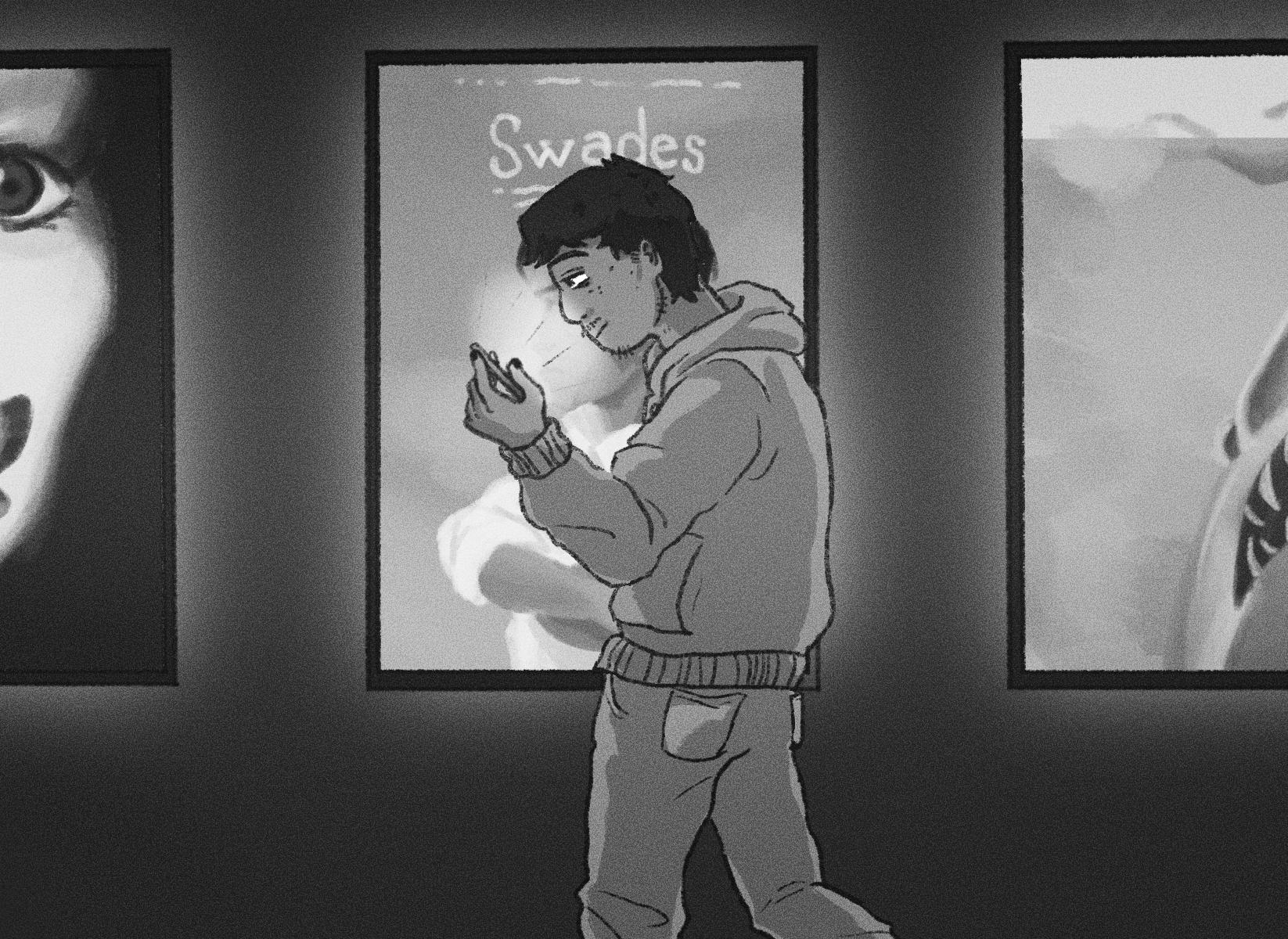
My friends and I were making a pit stop to roam a Target about 20 minutes outside Tampa.
We’d been driving for nearly two hours, and we needed some supplies for our beach day. In the back of the megastore was the sparsely stocked book aisle, where I picked up a blue-green copy of Sally Rooney’s “Normal People” almost immediately.
Then, I was suddenly struck by an odd scene: my friends, facing the bookshelves, staring directly at their phones and swiping their thumbs, brows furrowed. One turned to me with the screen displaying a TikTok of a blonde woman holding up a book and talking.
“They’re saying this one is actually good,” my friend explained. “I think I’ll grab it.” She reached for a red paperback, just like that.
We did something similar later in the day when we were looking for a place to eat. A few moments to scroll, a little debate and we found ourselves at a small Indian place with neon signs and pink walls. It was hardly the first time I’d seen something like this; I’ve noticed young people in my generation tend to look at TikTok reviews — or at least a Goodreads, Letterboxd or Beli one — before picking out a restaurant, movie or book.
I do think there’s something great about digital spaces where you’re able to engage in meaningful discussions about books, movies and food. I’ve definitely perused through some of these feeds myself (and, hey, maybe I even have both of these apps on my phone, so what). But, I knew things were starting to take a dark turn when my family was debating between seeing the new Jurassic World Rebirth or James Gunn’s new “Superman,” and I instinctively unlocked my phone and began scrolling to find reviews.
Modern technology has made it incredibly easy to curate perfect experiences. You can filter out bad hotels and restaurants with a simple “four stars and above” on Google. You can avoid reading a crappy book or watching a failed film by analyzing Metacritic reviews. It’s very clear why we choose to cherry-pick our experiences to be good, enjoyable and fun. Today, society moves faster than it ever has. Tomorrow, we will move even faster. In
2018, an analysis from Harvard University’s Harvard Business Review found that 80% of American respondents claimed that they did not have enough time — a number that rose 10% from 2011 to 2018. With the abundance of digital calendaring platforms, “away” or “online” markers on collaboration sites like Microsoft Teams and even the simple double-click iPhone mechanism to pay with your credit card, it’s clear that we value efficiency with our limited hours very highly in modern society. It stands to reason, then, that we strive to be as efficient with our time off work as well. Modern “hustle culture” has most corporate workers clocking in at least 40 hours per week in the United States. In a seven-day week, that leaves around 72 hours of free time given a nightly eight-hour rest. It’s understandable to want to maximize the joy one gets out of the little time remaining in the working world. So, if you’re finally getting away from the rat race to a retreat for the weekend, it makes sense to check the reviews first. Engaging with review culture reduces the risk of not being efficient with your fun.
But I worry that, by filtering out possibly “bad” experiences, we begin to live inauthentic lives.
Using an aggregated review system may make it harder for new up-and-comers to break into the restaurant scene. A self-publishing author finds it difficult to gain traction with their newest novel, no matter how incredible the piece may be. Directors stop casting based on talent and start looking for Instagram follower counts to build the ensemble of their film. Even more concerning is the lack of popular attention received by media that does not cater to American culture at all. As a result, the normal distribution of talent and artistry encounters a leptokurtic moment as consumers phase out what we deem to be irrelevant outliers. We miss out on good things in fear that we might get something bad.
The other side to the issue is that if we never have a subpar experience again, how should we know what is “good?”
The importance in forming one’s own opinion can’t be overstated. Canadian social psychologist Robert Vallerand claims that one’s passion is truly what makes one’s life

worth living. To find what it is we are passionate about — or even what we just like — it’s clear that experimentation is necessary. Are you sure you hate action movies? The only way to find out is to watch one. Love mystery fiction? I’m sure you picked up an Agatha Christie novel one day to figure out that part of yourself.
This summer, I deleted TikTok and Instagram to focus on my studies. Without the ability to scroll right at my fingertips at any given moment, I had to resort to learning about society by being in it, as opposed to watching it move past me through a screen. I wasn’t fully sure what the most popular shows and movies were, or which ones the hegemonic audience had decided were worth skipping.
Two experiences I had over this summer stick out to me in particular:
Three weeks ago, I sat down to watch a popular new horror film with my friend after a long day of pushing Anki cards through my brain. It was a terrible movie. But it was a great night, a soothing memory and a calm moment in what had been an otherwise hectic, insufferable week.
On the plane ride back from my hometown in India, I picked out a random film to watch.
The reviews were middling — “India’s most monotonous Bollywood movie”, one comment noted, “Shah Rukh Khan’s most boring role” said another — but I chose it anyway.
Three hours later, I was squinting to see the credits roll through my tears. What had been described as a quiet and detached film was one of the most beautiful movies I’d ever seen. The soliloquies felt like they were for me. The songs touched my heart.
The extensive review systems we use in the modern day to curate perfect experiences worry me. The possibility of missing out on something good, or even something awful that could reveal more about your own character, is the possibility of missing out on a piece of your life.
I encourage you to pick up a paperback based off of its back-cover description. Maybe even read a book based on the cover. Watch a movie because the summary piqued your attention, rather than the star count on the Letterboxd review. Live your life as authentically as you can.
Some days, I speak English so well I forget I used to have an accent. I slip into quick conversations, raise my hand in class, give presentations like it’s second nature. And maybe it is now. But there’s still a part of me that gets stuck when I speak, like something’s missing, like I’m holding back.
That part is Twi.
It’s the voice I hear when my mom yells, “Adwoa,” my Twi given name, from the kitchen. It’s the prayers at church, the ones we say before we eat, before we start the day, before anything important. It’s the background of phone calls with family, filled with laughter and homesickness. Twi was never just a language. It was home, it was connection.
It’s not gone, not really, but I don’t speak it out loud much anymore. Not here. Not in front of people who pause when they hear something unfamiliar, something “foreign.” I used to try, but then came the stares, the jokes, the way people reacted when I opened my mouth. You start translating yourself before anyone asks. And after enough time, even your words are not your own.
In Ghana, almost everything was in Twi. During blackouts, my grandparents told folktales about Anansi the Spider, the trickster and his adventures. In Twi, the emotions came alive. The stories were more vivid; we laughed when the characters laughed, and every detail felt so precise it seemed made for the language itself. To this day, I still remember almost every word. To me, Twi was celebration, an invisible string that tied everything together; the stories, the laughter, the traditions.
Even though English is the official language of Ghana, schools made sure Twi is a part of the curriculum. Every day for two hours, I sat in front of my teacher trying to tell the letters apart, “e” and “ ɛ ” Another language spoken around me was Ga, but as a native Twi speaker I never needed it. Everyone I cared for or spoke to understood Twi.
“Our Day” was the name of the ceremony that marked the end of the school year. We wore our best clothes, the kind saved for church. Families cooked food to share with classmates and teachers. On that day, English seemed to disappear. The songs we would sing to commemorate the school year coming to an end were still in Twi. It felt like our own bubble of language, continuing to grow around us.
Why switch to English when Twi conveyed everything so easily? Those days made me feel like I belonged to the largest community in the world. Twi was our connector, like a phone number everyone knew by heart. I grew up in Ghana. I went to school there. I lived there. Laughed there. I had the thickest accent, the kind people here joke about on TV— but back in Ghana, it was just how we spoke. I never thought twice about it. Then I moved. And suddenly, everything flipped. The same voice that felt normal in Ghana became “hard to understand” in Chicago. People squinted when I spoke, like they were trying to decode me. Teachers didn’t even try to say my last name right. I started westernizing it just so I wouldn’t have to keep correcting them. I felt like an echo machine, repeating myself over and over, slower and softer each time, like I had to translate who I was just to be heard. Kids found everything funny: my accent, my words, even the way I said “hello.” I quickly learned that being different meant being entertainment.
Back then my voice was nothing to wonder at but now it was a spectacle.
I always loved telling anyone around me about the new books I read; I could go on tangents about the characters and settings. Once, in the middle of a debate about how Jason is the best character overall in “The Heroes of Olympus” series, I made the cardinal sin of saying a word “wrong.”
Some words are more difficult to pronounce than others without the unwanted accent. I never thought much of it, so when I said the word “embarrassed” and heard a snicker, I just moved right past it. It was only when they started repeating the words to me that it began to affect me. “Embarrassed,” they would say. It’s just like how I said it but with my apparently thick accent it was almost too “Africanish.”
To them, I sounded exactly like the stereotype on TV, but to me,that was just how everyone I knew sounded. I laughed with them pretending it didn’t matter. Though after that day, I worked hard to make sure that everything I pronounced sounded “right”, and if it didn’t, I wouldn’t say it ever again. When I pronounced things “wrong,” people laughed and I laughed too, but mine was thinner, more drained. It shouldn’t have been this hard. Moments like these taught me that my voice always had to adjust, that the way I used to speak needed to be “fixed” and that westernizing it felt safer.
I didn’t hate my voice, but I hated how people responded to it. So I adjusted. I stopped putting emphasis on certain words. I started spelling “colour” like “color.” I stretched my words out but slowed them down enough to sound “smart.” I watched shows to practice. My screen time climbed to almost six hours every day. All I did was practice and practice. In front of the mirror, I practiced. I read books out loud so no one would ever ask me to repeat myself. I started avoiding words I couldn’t say “right” and found easier ones to replace them with. I was fast at learning. I quickly picked apart and reshaped pieces of my speech to feel safer, to blend in instead of being entertainment. I softened. I strived to say things “the right way,” even when they didn’t feel like mine. That’s how it happens. Not all at once. But slowly, piece by piece, you leave things behind.
And yet, Twi never left me. Its lifeline still lingers in my family, glowing in my mother’s pride, in my sister’s quiet understanding and even in the silence of cousins who can barely speak it anymore. At home, it slips out when my mom tells me about her day, or when she yells at my sister and me to come to the kitchen and watch her cook. She switches to English, sometimes our fault — because we’ve gotten used to answering her Twi with English but even then, it reminds us of where we’re from. When we sing hymns in Twi, it feels like the language brings us closer. On family WhatsApp calls, my grandparents begin with “Wo ho te sɛ n?”— how are you? — asking about our lives and reminding us of the importance of school. Everything is in Twi: the food, the greetings, the prayers. It isn’t always spoken, but it is always there, sprinkled through our days holding us together.
Since I’ve started school here, I’ve noticed how language is an art. In Spanish, saying “te amo” carries a weight, a rhythm, a cultural pride. And in Twi, the word “akwaaba,” welcome, holds that same kind of depth. It’s everywhere — in songs, on posters, in every place you go — a reminder of the welcoming nature of the language. This word isn’t just an emotion written down; it creates vivid images of community. Hearing it around me brings me so much pride and joy for my people. Words are a way of showing love. Some days when I’m in a crowd and hear the name Hilary, I don’t turn around. There’s so many Hilarys around. But the moment my mom calls me “Adwoa”,I remember. Twi is still here. Twi is alive.
Edited and managed by students at the University of Michigan since 1890.
Stanford Lipsey Student Publications Building 420 Maynard St. Ann Arbor, MI 48109 tothedaily@michigandaily.com
ZHANE YAMIN AND MARY COREY Co-Editors in Chief JACK BRADY AND SOPHIA PERRAULT Editorial Page Editors
Mateo Alvarez
Zach Ajluni
Angelina Akouri
Jack Brady
Gabe Efros
Lucas Feller
FIONA LACROIX AND CECILIA LEDEZMA Managing Editors
EDITORIAL BOARD MEMBERS
Liv Frey
Seth Gabrielson
Jovanna Gallegos
Jack Kapcar
Tate Moyer
Tom Muha
Sophia Perrault
Hunter Ryerson Maximilian Schenke
Lindsey Spencer
Audra Woehle
Zhane Yamin
Sarah Zhang
Unsigned editorials reflect the of f icial position of The Daily’s Editorial Board. All other signed articles and illustrations represent solely the views of their authors.
Daily: UMich turns the student code of conduct into a tool for repression
THE MICHIGAN DAILY EDITORIAL BOARD
On Sept. 8, Erik Wessel, director of the University of Michigan’s Office of Student Conflict Resolution, announced a new series of amendments to the Statement of Student Rights and Responsibilities, which details how students should conduct themselves on campus and how they can be punished for alleged infractions.
Conveniently, Wessel failed to announce all of the proposed amendments and wording that the administration rejected or changed. The University’s response to these proposals, obtained by The Michigan Daily, reveal its intent to create a campus where rules advance the capricious will of the administration, rather than protect the people who fall under their purview.
What happened
The statement is scheduled to be amended once every three years, at which point the Central Student Government, Faculty Senate and all University executive officers are invited to propose changes on behalf of their constituent groups. These proposals then go to the Student Relations Advisory Committee — part of the Faculty Senate — to be compiled and presented to the U-M president for acceptance, revision or rejection.
This year, SRAC advanced 19 proposals in total — including alterations to both the disciplinary and amendment processes. Four were accepted fully, four with revised wording, ten were rejected outright and one remains under consideration.
At best, Wessel’s email was disingenuous. At worst, it was an outright lie. SRAC’s proposed language was not “approved,” as Wessel put it, but substantially rewritten. In several particularly egregious cases, the statement now says the exact opposite of what SRAC recommended. This Editorial Board has been warning for nearly two years that the administration is taking steps to curb free speech and undermine student rights. With the latest amendments to the statement, however, the University has hijacked the rulebook and codified its campaign of repression.
If you’re getting deja vu, you’re not alone.
This isn’t the first time U-M leadership has approved restrictive amendments to the statement. The administration last revised the document in July of 2024 — outside of the traditional three year cycle — when former University President Santa Ono and the University’s Board of Regents effectively rigged the disciplinary process against students. In only 40 seconds, without any community input, they whittled the appeal window down from 10 academic days to five; replaced an impartial Appeals Board with the Vice President for Student Life; allowed the University to act as a complainant against students; and revoked students’ ability to discuss potential punishments before entering a plea agreement.
In response, this Editorial Board wrote that the administration was turning its back on student rights. At the time, we viewed the amended statement as a sort of apex — the capstone to a year of harsh crackdowns on protests and speech. We now see it as
a catalyst, accelerating the construction of a disciplinary apparatus that the University can aim at whoever it deems threatening. Amid our volatile campus climate, that could be anyone.
The proposed amendments
The Editorial Board identified six proposals that clearly illustrate the University’s priorities.
The proposed language added a singular phrase to the statement: “political protest.” Given the administration’s history of exploiting vague language in the rules, explicit protections for this type of speech were the only way to ensure it remained free.
The University rejected SRAC’s recommendation on the grounds that, as a public institution, it “cannot prefer or protect political expression over other types of speech. Doing so would constitute an impermissible content restriction.” We argue the opposite: Failing to guarantee the freedom of protest is the definition of a content restriction. With these changes, the University is permitted to subdue any protest they deem a disruption, no matter how flawed its reasoning may be.
With this revision, Interim University President Domenico Grasso and the regents say the quiet part out loud. They would have lost nothing by accepting this proposal — but rejected it anyway. This Editorial Board, like much of the U-M community, has long doubted the administration’s commitment to a fair disciplinary process. But now, even the illusion is gone. There are some ideals worth putting in writing, especially in a judicial context, and fairness is one of them.
CONTINUED AT MICHIGANDAILY.COM
JARED ENO, MICHAEL MUELLER, KATHLEEN BROWN, ASSMAA EIDY, DRIN SHAPIRO, OLIVER KOZLER, EAMAN ALIZADEH, JEFF HOROWITZ & SADIA HAIDARI Opinion Contributors
For the past two years, the world has watched as Israeli occupation forces have enacted a genocide, destroying Palestinian civil society, infrastructure and lives — a modern holocaust committed with United States-provided weaponry and support. In addition to the U.S. government, institutions from pension funds to universities are heavily complicit in funding and legitimating these atrocities.
The University of Michigan not only brings perpetrators of genocide and war profiteers to campus as celebrated partners, but via its more than $19 billion investment portfolio, contributes financially to an ecosystem of drone manufacturers, surveillance technologies and other enterprises murdering Palestinians.
In response to this depraved situation, silence and complicity are not options. Those in Palestine have continued to resist their dispossession courageously, and it is incumbent on all of us — particularly in the United States, Israel’s biggest financier — to heed their call and struggle for boycott, divestment and sanctions. Students, staff and community members across Michigan have rightly taken action demanding the University divest its ties to genocide, meeting predictably with severe blowback from an institution that values profit more than Palestinian lives.
We, a group of students and alumni, have been subjected to student discipline by the Office of Student Conflict Resolution and the new Office of Student Accountability for participation in pro-Palestine actions such as the 2024 Gaza solidarity encampment.
We write to clarify the role of these offices in the University’s antiPalestine repression and to urge readers to join the defense of our movements under attack.
Student disciplinary processes at the University date back decades and have a sordid history. In the “No Cops, No Guns, No Code” movement of the late 1980s, students fought against the administration’s push to establish a code of non-academic conduct alongside the deputization of an armed campus police force. They recognized that these measures, far from improving campus safety, would give the University’s Board of Regents new tools to quash political opposition on campus — which in the 1980s had included direct
action by the United Coalition Against Racism and the movement for divestment from apartheid South Africa. While referenda in both 1987 and 1992 showed that students overwhelmingly opposed the administration’s process of forming a code, the regents nonetheless passed the first Statement of Student Rights and Responsibilities in 1992. When the University could not count on external police and prosecutors to effectively deter anti-racist and anti-apartheid protests, they developed new methods like campus bans and student disciplinary proceedings to chill opposition. Today, unable to secure criminal charges against proPalestine protestors, they are finetuning their campus prosecutorial powers.
The political nature of the student disciplinary procedure is as clear as ever. The regents have weaponized OSCR, supposedly in the name of ‘restorative’ and ‘educational’ practices to address harm. But they align with President Donald Trump and other national forces when they demand that pro-Palestine protesters — from demonstrators at the 2023 Alexander G. Ruthven Building sitin to those at the 2024 encampment and beyond — be punished. When the regents couldn’t secure criminal charges through Michigan Attorney General Dana Nessel or local prosecutor Eli Savit, they built their own prosecutors’ office through OSCR and OSA to sanction us anyway.
This summer and fall, we all received notice that the University was pursuing disciplinary charges against us. These disciplinary proceedings face ongoing legal challenges for their many absurdities. For instance, the charges arose for incidents a year or more after they occurred, despite the statement including a 6-month deadline. The same individual (OSA Manager Donovan Golich, of University of Virginia notoriety) serves simultaneously as complainant on the University’s behalf, as the investigator in our cases, and also as the Resolution Coordinator (who oversees the disciplinary process) — essentially a combination of victim, prosecutor and judge in a criminal case. While the statement allows for student panels to decide cases, none of us were allowed this option. In many of our cases, the University simply overrode the rulings of Resolution Officers after the fact, with Dean of Students Laura Blake Jones deciding escalated sanctions (including disciplinary probation until graduation and bans on alumni re-enrollment). Simultaneously, Human Resources has unilaterally banned many of us — sometimes twice over —from employment at the University.
The purpose of these disciplinary charges is not only to punish people of conscience but also to distract from the regents’ own violence. They have defiantly provided political and financial support for Israel’s genocide of Palestinians, even as Americans and people across the world turn against the settler colonial apartheid project. The regents have used police violence to avoid public accountability for their funding of the extermination of the Palestinian people. The disciplinary charges seek to turn this situation on its head and brand the people protesting genocide as violent. We must be clear: The regents are responsible for violence, both in Gaza and on our campus.
In many ways, it is no surprise that the University resorts to extremes where Palestine is concerned. All the evidence shows that the regents would rather institute repression and surveillance than endanger their bottom line by heeding the popular demand to divest from the murder of Palestinians. As people of the University and of the state of Michigan, we must organize, disrupt their status quo and defend each other.The stakes of student disciplinary proceedings, like other repressive measures, are significant for all on campus who organize for justice. For student workers, such as those in Graduate Employees’ Organization and ResStaff Allied Organåization, student disciplinary proceedings can allow administrators to ignore contractual grievance procedures and suspend workers as retaliation for union activity (such as striking and picketing).
Any organized campaign against the University’s unjust policies — from dismantling diversity, equity and inclusion and building a “national security” data center in Ypsilanti against residents’ wishes, to halting gender-affirming care for patients under 19 — must reckon with a militarized campus environment whose administrators implement practices favored by the Trump administration. U-M administrators have stated their intent to “hold individuals accountable for their actions in order to ensure a safe and inclusive environment for all.” We couldn’t agree more that acts of harm must be met with accountability: The regents, who steadfastly refuse to cease funding the murder of Palestinian families and directing police violence against our community, must be held accountable. Disrupting a genocide is a moral responsibility, not a cause of harm, and we all have a stake in defending resistance against the regents’ rule.
Why Trump would be perfect for an honorary U-M doctoral degree
ROI LIVNE, REBEKAH MODRAK, STEFAN SZYMANSKI, JOHN WOODFORD & BASIT ZAFAR
Opinion Contributors
Dear members of the University of Michigan’s Honorary Doctoral Degree Committee, It is with trembling hands and a certain degree of anxiety that we are writing to make the inevitable nomination of President Donald Trump for an honorary doctoral degree from the University of Michigan. We cannot imagine a more appropriate candidate in the current historical moment. Trump represents our University’s values and ethical convictions like no other. He has not only provided the political climate and resources for the University to turn into the empty shell that it now is, but has also given so many in our leadership the
inspiration to crack down on civil and constitutional rights, attack academic freedom and turn their back on common human decency. Many have characterized Trump as an amoral person who is incapable of understanding actions that are not guided by pure self-interest. By this criterion, the University is now quintessentially Trumpian. We are denying children genderaffirming care, we made cuts to diversity, equity and inclusion programs and we laid off relevant staff and faculty. We have proven that we have no hard moral principles and no hill on which we will die. Everything we once stood for has now melted into air and been thoughtlessly sacrificed to preserve our organization’s financial and political standing.
Awarding Trump an honorary doctoral degree would be an opportunity to recognize the long way the University has walked in less than two
years. U-M juniors may still remember times when the campus code was determined through collaboration between faculty, staff and students, and then respected and followed by University administrators. This is called democracy and shared governance, and we used to care about both. Today, the higher administration unilaterally rewrites codes and procedures while it is charging students and staff with various violations. Some of us may remember times when the Office for Student Conflict Resolution worked on resolving student conflict. Today, this office functions as a judicial arm that disciplines politically active students based on complaints that the University pays external companies to submit. Only a few years ago, employees who faced serious charges received a hearing and due process. Today, pressure from an angry regent over an anonymous and unsubstantiated complaint is

sufficient to summarily fire a senior staff member.
Examples are plentiful, but the big picture is clear. The undercover investigators the University hired to follow some of its politically active students, and the regents who circumvented the county prosecutor and compelled the state attorney to file felony
charges against students, are testimonies that the University is now operating by Trumpian standards and epitomizes the president’s vision for the United States. Our faculty are afraid of teaching, our students are afraid of speaking and free expression is a relic of the past. The collapse of academic freedom that we are witnessing on our campus mirrors the collapse of democracy in the entire country. Awarding Trump an honorary doctoral degree will give credit
GUNNAR HARTMAN Opinion Analyst
kicked down his door and handcuffed him in front of his children. The police arrested Bivens on narcotics charges and strip searched him without a warrant. Bivens sued the agents for violating his Fourth Amendment rights, and the Supreme Court ruled in his favor. Almost five decades later, in 2021, Erik Egbert, a Customs and Border Patrol Officer, illegally entered inn-owner Robert Boule’s property and assaulted
him. Boule also filed a lawsuit for Fourth Amendment violations, a case which made its way up to the current Supreme Court. That court reversed Biven’s ruling, decreeing that private citizens do not have the right to sue federal officers for violating their constitutional rights or using excessive force.
Fast forward three years, and President Donald Trump begins his second term. Deportations soared, as did reports of masked agents committing flagrant acts of brutality. Videos online show officers smashing car windows, punching detainees and, in one case, body slamming a harmless female bystander. These officers are unaccountable to their victims,
and there are no reports of these officers facing any punishment from supervisors either.
The Trump administration has expanded the Immigration and Customs Enforcement budget beyond the size of most European militaries and plans to hire 10,000 new employees for the agency. They’ve also demonstrated that they’re willing to use federal power on any citizen, politician or state that stands in their way.
An unchecked, militarized police force is a ticking authoritarian time bomb. At the very least, Americans should be able to sue these federal agents for excessive force or violations of the constitution.
Let’s assume (hypothetically, of course) that sycophantic political appointees are running these departments with no intention of actually respecting the processes of the offices they oversee. Then, ICE agents suddenly have no one capable of checking their power, and victims of federal abuses are left with no place to turn to.
Of course, this reality is precisely what supporters of the Bivens decision fear. If the constant threat of a civil suit hangs over officers’ heads, maybe police will approach detainment operations with more caution. Split-second decisions can save lives, and this extra time spent deliberating could have deadly consequences.
However, this is not the case. Especially at the federal level, agents go through extensive training to prepare for these exact scenarios.
DOJ and DHS provide thorough guidelines for what officers can and cannot do — whether officers follow them is a different story.
2025 inauguration, the first ICE agents were in Ann Arbor. The University released guidance back in January outlining what members of the U-M community should do if confronted by ICE. The guidelines reflected the utter powerlessness of the University in the face of such an encroachment on our community. The guidelines read like the protocol for a helpless hiker confronted by an angry bear: stay still, remain silent and do not provoke. The lack of instruction for people who found themselves on the receiving end of an ICE raid was also striking.












































































































































Courts have historically provided deference to police recognizing heat-of-the-moment decisions and can reasonably differentiate between a genuine constitutional violation and a guilty suspect.
















Like most law enforcement agencies, ICE falls under the command of the U.S. Department of Homeland Security, led by Secretary Kristi Noem. Theoretically, it also must abide by federal law, enforced by the Attorney General Pam Bondi and the Department of Justice. A little accountability goes a long way, but so far, ICE has almost none.


As members of a public university open to warrantless raids at any time, the University of Michigan community is in dire need of this basic legal shield.


In short, Americans have little recourse in the face of an increasingly hawkish federal police force, perhaps hinting at why the legal equivalent of rolling over and playing dead has become the en-vogue recommendation by universities to students experiencing these raids in real time. Now imagine a parallel reality, where it is the federal agents receiving guidelines from their administrators, encouraging them to enforce the law, but also warning that careless abuse and excessive violence could bring lawsuits. Maybe they would think twice before shoving senior citizens to the ground.
Less than a week after Trump’s
We aren’t just U-M students. We’re also belong to both the city of Ann Arbor and the United States. That comes with the obligation to look after these communities and the most vulnerable within them. It also demands that we hold those in power accountable, not to our own whims, but to the constitution they swore an oath to protect and serve. True law and order only comes when enforcers are liable for their actions.







































































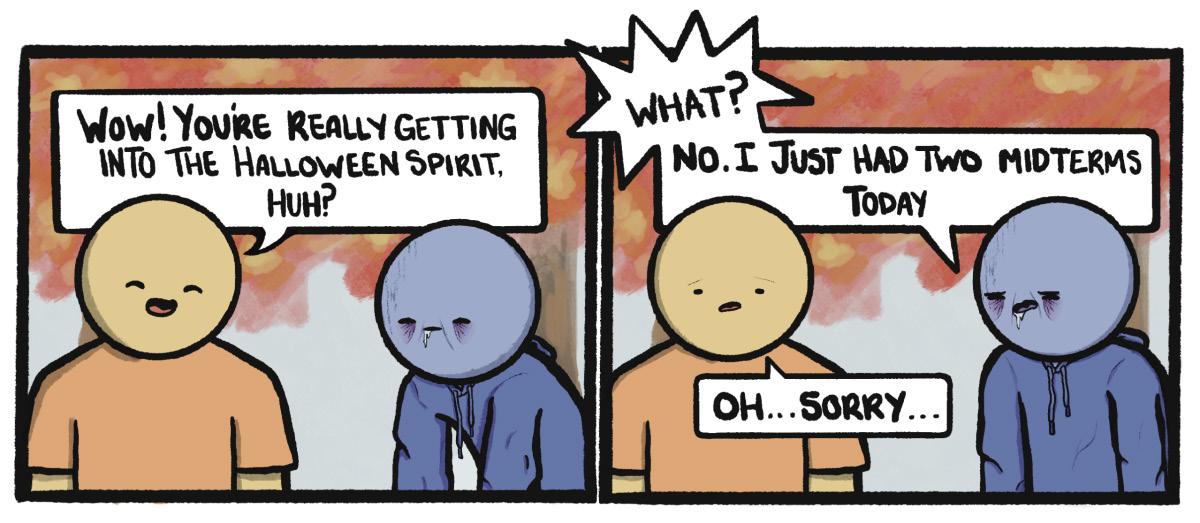






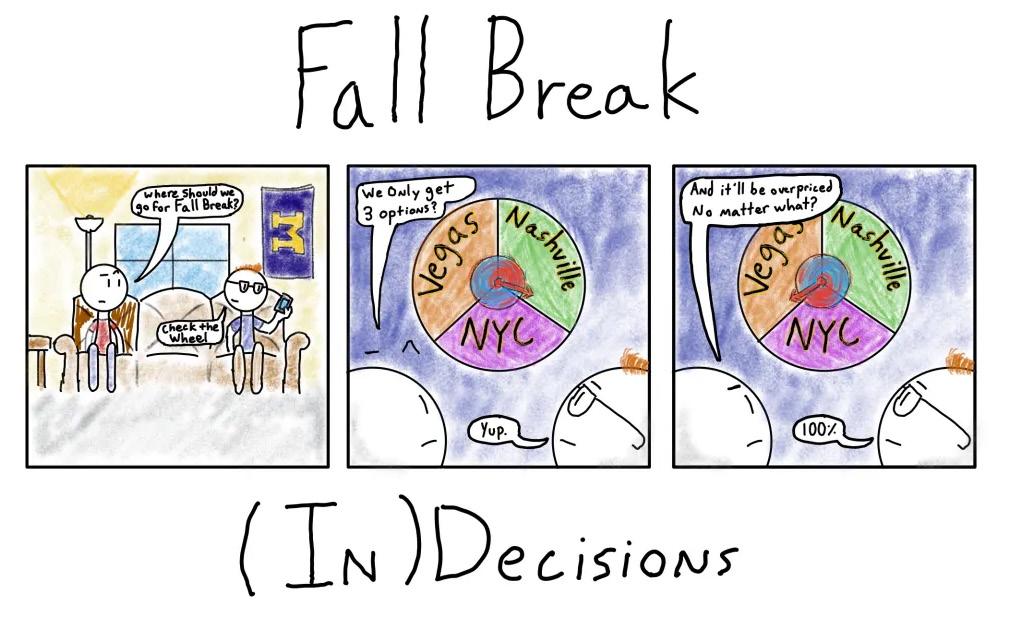
NOLAN
SARGENT Statement Correspondent
Most people are casual texters, playing fast and loose with the conventions of grammar, syntax and spelling in order to achieve their desired tone. They don’t bother to capitalize unless they’re using caps lock, they only use what punctuation is absolutely necessary (or less) and they pay little attention to spelling. Not me. I text with proper grammar, spelling and punctuation. Always. Even when I’m drunk — which has only been a handful of times since I just turned 21 and I have great respect for the law — I take extra care to ensure that every last period is in place, every word spelled correctly. And I never use emojis.
Why?
Am I a psychopath?
Possibly, but I don’t think that has anything to do with it. I’ve been texting like this my whole life, and I think there are a few reasons. Firstly, I just take pleasure in it. It’s satisfying for me to keep my texts consistently proper. Additionally, when I started texting like this I was pretty pretentious. Okay, I’m still pretty pretentious, but I was super pretentious back then. If I’m being honest, (and please keep in mind that I was very young) texting with proper grammar and spelling made me feel a little smarter than everyone else. I wasn’t like the rest of my generation; I cared about grammar and respected the English language. Also, I just love committing to a bit. I’ve been doing this for a decade at this point. Why stop now?
Above, I rhetorically questioned whether I text the way I do because I am a psychopath. People have actually said this, although in hyperbolic jest. A friend once told me that the topic of formal texting came up in her communication class and even the professor said,
KATIE LYNCH Statement Correspondent
Like many others, my adolescence was demarcated by a series of important milestones that indicated the excitement of growing older: playground crushes, after-school trips downtown with friends, receiving my very own house key. But around the time I hit puberty, the milestones started to take a different, bleaker turn. I remember being catcalled for the first time, getting dress-coded at school for wearing running shorts on an 85-degree day and hearing stories of boys pressuring my friends into doing things they didn’t really want to do. It made me feel ashamed of my body and the space it took up, and scared of moving freely in the world around me. I craved something tangible that would allow me to reclaim a semblance of my autonomy.
Then, during my senior year of high school, just before my friend and I were planning to leave for a road trip to Florida, my parents gifted me a hot pink canister of pepper spray. For the next four years, it would remain attached to my keychain, accompanying me everywhere I went, granting me at least the illusion of control over my body and my safety in a country that seemed to care about protecting these things less and less. The pepper spray was, in my mind, the ultimate ironic symbol of femininity — a cute (if not somewhat gaudy) trinket, a symbol of sisterhood, but also an image indicative of the nebulous threat supposedly awaiting women around every shadowy corner, beneath every flickering streetlight.
“I know you know this,” my dad tells me over the phone any time I accidentally let slip that I’m about to be walking alone somewhere late at night, “but be careful.”
“Daaaaaad,” I say back to him, rolling my eyes. “I’m fine, old man. Go back to your crossword.”
I joke because I must; the threat is not so nebulous and I know this. The National Sexual Violence Resource Center reports that one in five women experience sexual assault while in college, and this number is increased for individuals with intersecting marginalized identities.

Yes, I always text like this. No, I’m not going to stop.

“That’s how a psychopath texts.” And that’s a communication expert talking. Despite the hyperbole, this does highlight a genuine negative reaction to my texting style, which is not uncommon. At the very least, most people think it’s a little bit weird. Some find it confusing, unable to tell if I am mad at them due to my committed use of periods. For example, when I pitched the idea for this piece, my editors noted how even in our professional text conversations, they have wondered if I was upset at them about something. As it happens, I was mad at them for making me cut my fiveparagraph beat-by-beat analysis of Ben Shapiro’s reading of “WAP”
by Cardi B from my last article on debate bros. However, I swore I wasn’t upset about anything, so please don’t tell them. In addition to expressing confusion, some people have even taken issue with the way I text and have asked me to stop, which I will not. Why do people have such strong reactions to this texting style? I suppose the main reason is that it impacts tone. The same words can be read differently based on how they are presented. The presence of a period at the end of a text, for example, can be interpreted to represent anger because it is a deliberate, out-of-the-way addition that feels final and closed off. In broad terms, the use of proper
grammar creates a more formal tone, which can produce a sense of distance. It seems to suggest that the author is hiding part of their true self behind formality, which I believe leads the respondent to feel less comfortable with being fully themselves. In reality, I make a choice to use this style because I feel that it better reflects my personality as compared to a casual style of texting. If I were to text more casually, it would feel inauthentic because it would not sound like me. The way I actually speak tends toward formality due to my word choices and how I construct sentences, so it would feel strange for me to shift into an informal style when I text. Others have come
Gabby
Spagnuolo/DAILY
to associate me so strongly with this formal texting style that they recognize my texts in a group chat even before reading my name. If someone else uses proper grammar, others in the chat will be confused and assume it’s me. This texting style has become a genuine and authentic part of my personality. Another reason people might react negatively is simply because this style of texting is outside the norm. When things don’t align with people’s expectations, it can naturally annoy them. This isn’t the most insightful point, but I think there’s something more to be said here about conformity and nonconformity. It is the norm, at least among young people, to
Your pepper spray isn’t really keeping you safe
In particular, during the first semester of college, a period of time dubbed “The Red Zone,” more than 50% of all sexual assaults on college campuses are found to occur. I know these numbers, I know to be careful and I know the consequences of taking my safety for granted.
Thus, my hot pink pepper spray was my security blanket throughout my first five semesters of college. I was prepared to take it with me to my sixth semester too, as I boarded a plane to Dublin, Ireland (after confirming that containers of mace below four ounces are Transportation Security Administration (TSA)-approved) and made my way across the city to my accommodation. However, I quickly learned that while I’d been foolishly caught up in the question of whether my purple knitting needles would get flagged by airport security or if I’d be able to get my Prozac prescription refilled while abroad, I hadn’t fully thought through the pepper spray — which has been illegal in Ireland since 1925. Bidding a teary but immediate goodbye, I got rid of it.
Like I said, up until this point, it was a habit for the pepper spray to come with me everywhere, including to places where it probably shouldn’t — to class, to the neighborhood coffee shop, to the grocery store on a Sunday morning. For the first few weeks in Dublin, sans-hot pink pepper spray, I felt a little uncomfortable, my keychain considerably lighter. In the United States, I never used the pepper spray, but could remember many a late night spent walking home with it by my side, anxiously eyeing groups of drunk men stumbling down the sidewalk ahead of me. Whether these perceived threats were genuine or just consequences of my overactive imagination remain unclear, but I do know that having the pepper spray in my hand brought me some comfort. The thing is, though, that’s all the pepper spray did — I’ve never actually used it, and walking around late at night in Dublin without it, I didn’t feel more unsafe than I typically did while walking around in the U.S. Soon enough, the realization that I’d never even come close to using the pepper spray sank in and I grew to feel fully at ease without it.
It was a strange experience. For the first time since the weapon had been introduced to me, I was starting to question whether or not I really had a grasp on the efficacy of the role that pepper spray served. For all of these years, I had been carrying it under the guise that I’d be able to fearlessly spray it in the eyes of an approaching attacker on the street, but in reality, I’d only skimmed the directions when I got it and didn’t really have confidence in my ability to find, unlock and position it in a stressful moment.
I had thought pepper spray was considered such an objectively good tool for disempowered and vulnerable populations to have access to, but suddenly, faced with the existence of century-old legislation that argued vehemently against it, lumping it in with the likes of firearms, I was confronted with the possibility that maybe pepper spray posed more of a threat than what was offset by the safety it assured, especially when placed in the hands of untrained individuals like myself. Maybe its popularity was, in part, a consequence of the commerciallysuccessful Girl Power movement, rooted in American individualism and the tunnel vision notion that we can do anything, including taking matters into our own hands and standing up for ourselves however we see fit. I wondered if the sense of emotional security pepper spray let me experience was truly justification enough to carry it. In Ireland, there’s a movement expressing backlash against this law that bans pepper spray. Proponents like Irish Senator Sharon Keogan argue that women in Ireland are increasingly feeling unsafe and that legalizing pepper spray would help to alleviate some of their fears associated with this. But this argument isn’t really about pepper spray, I don’t think; it’s about women who are fed up with being at the whims of the sexual violence that permeates so much of Irish and American culture. In this way, the push to legalize pepper spray abroad distracts from the root of the problem that cultivates a culture where women continue to feel unsafe.
In an interview with The Michigan Daily, Elizabeth Armstrong, University of Michigan Sociology department chair, described how the prevalence of people carrying pepper spray, especially on college campuses, is rooted in a fundamental misconception that most sexual violence takes places at the hands of strangers when, in reality, it’s most often perpetrated by someone in one’s social circle.
“I find it really baffling, actually, because one of the central goals of sexual assault prevention work pretty much since the late ’80s has been an effort to try to get young people to understand that the risks were vastly more within the social worlds they move in than from strangers,” Armstrong said. “It’s baffling that this message doesn’t seem to hold, because there have been so many decades where that communication has been reiterated again and again.”
This misunderstanding of where the risk is statistically concentrated is central to understanding why students care so much about tools like pepper spray that would, in theory, allow them to protect themselves on the street. But the risk isn’t in leaving the party, Armstrong argues: “The risk is in staying.”
The fact that this message has been communicated without sticking for 40 years suggests serious flaws in the structure of American sexual and reproductive health care education. These failures have been welldocumented in academic and political spheres, and yet the disconnect stopping people from acting upon it persists. Emotionally, this makes sense; nobody wants to imagine that the people close to you will hurt you. But there are bigger issues at play holding women and Queer groups back from speaking out against violence when it takes place. The research of Charlene Senn, psychology professor at the University of Windsor, explores this, highlighting what Armstrong describes as “all the steps one would actually need to go through to feel psychologically and physically empowered to take a stand” when faced with a potential threat.
“When I was in college taking this women’s studies course, I realized that no one in my life had ever, up until that point, taught me that I would have permission to, in fact, even just yell if some guy sitting next to me on the bus put his hand on me,” Armstrong continued. “If one doesn’t have any kind of sense of an entitlement to
disregard the rules of grammar when texting. This refusal to conform to the rules is what creates the casual tone associated with texting among the younger generations. However, this rejection of rules becomes its own set of rules, leading to objections when the rules of informality are not followed. When I choose to follow the rules of proper grammar and spelling, my failure to conform to the expected texting style can confuse people. Looked at a certain way, it’s a paradox. In conforming, I fail to conform. In order to conform, I must fail to conform. This represents a broader phenomenon which has been strengthened in the era of algorithms: Young people seeking individuality wind up converging on the same aesthetic tokens of individuality. While we desire to distinguish ourselves as individuals, we specifically want to do so in a way that garners the respect and admiration of our peers. In other words, we want to seem cool, so we are constrained in our attempts at uniqueness by what others will recognize as cool. Another interesting takeaway from observing the tension between my texting style and that of the majority of people my age is the way in which the medium of communication impacts its form. When I use a formal-seeming style in a friendly text, it sticks out. However, you wouldn’t think twice about receiving an email in a similar style, even in the context of the same interpersonal relationship. It may even seem to be lacking in formality without a line addressing you directly by name and another signing my own name. On the other hand, if you received an email as casual as most texts between friends, you would probably be confused. You might not mind, but it would certainly appear incongruous.
CONTINUED AT MICHIGANDAILY.COM
one’s own physical space or had any kind of role-playing in how to be assertive or how to yell, carrying something on one’s keychain that has a complete psychological disconnect from how one would ever feel comfortable manifesting itself in the world seems kind of bizarre.”
Armstrong pointed out that there are tangible institutional changes that can be made to limit circumstances where risks of sexual violence are higher, some of which are already happening at the University. Access to safe late-night transportation options, such as the Center for Global and Intercultural Study’s (CGIS) piloted program that offers discounted “Night Owl” Lyft rides for students and medical amnesty laws that make it easier for intoxicated minors to receive medical attention without fear of persecution or academic consequences, are two examples of this.
“There are ways that space is set up that can be more or less risky,” Armstrong added, listing as examples fraternity parties where men control the flow of alcohol and dorms where beds are the focal point and other common spaces are limited.
CONTINUED AT MICHIGANDAILY.COM

LISKA TOROK Statement Columnist
In sixth grade, I watched a documentary outlining the environmental harms that come with eating meat. Not long after, I became vegetarian.
At the time, it was a very straightforward and easily calculated decision: Eating meat was harmful to the environment and I cared about the environment, so I should therefore stop eating meat. However, as I grew older and those around me became more opinionated, I slowly began to question the impact my individual action made and, consequently, if it was worth sacrificing an entire food group for.
I’ve never been a “good” vegetarian. And by that, I don’t mean I eat meat, but rather that I want to. Despite having withheld my desire for more than eight years, I must admit I crave a burger every time I see one. All this to say, not eating meat is a sacrifice to me. I take a million supplements, became anemic for a period of time and don’t think I’ve eaten the recommended amount of protein since before I began college. Even then, the wellbeing of the planet means more to me than a few extra visits to the doctor.
Interestingly, I took an ethics class where we coincidentally studied marginal cases, which include humans with diminished cognitive abilities and non-human animals. This was explained in a 2004 article published by Alastair Norcross, professor of philosophy at Rice University, who discussed the extent to which these marginal cases deserved human-like treatment. The main argument Norcross made that interested me — beyond the ethics of factory farming — is whether or not giving up factory-raised meat makes any sort of difference on an individual level. Norcross argues that even if an individual’s decision to stop eating factory-raised meat seems too small to make a difference, it still holds moral significance; this idea is referred to as causal impotence. Norcross went further, using chickens as an example. He estimated that if 10,000 people stopped eating chicken, 250,000 fewer chickens would be bred and killed each year (estimating that the average person eats 25 chickens a year). This means that one person’s choice has roughly a one in 10,000

chance of preventing immense suffering for a huge number of animals.
While this may seem insignificant or too much of a hypothetical to justify sacrificing meat, Norcross argues that even a small probability of preventing great harm carries serious moral weight. We take action in other situations where we act responsibly despite low odds of them being necessary, like ensuring airplanes have functioning safety equipment. While the probability of these small actions making a difference is low, that doesn’t excuse inaction because the potential harm is so great. Essentially, according to Norcross, an individual can still have a meaningful moral impact by refusing to consume factory-farmed meat, since even a tiny chance of preventing massive suffering makes the action morally significant.
I think I agree with Norcross in terms of my own life. The chance of individual action making a difference in terms of something as significant as irreversible climate change is worth potentially giving up meat for “nothing.” Personally, I’m willing to accept that, even if the odds are against my individual action making a difference, I feel like it’s undeniably better than doing nothing. It’s something within my control that has a chance of mitigating or slowing climate change, no matter how small an impact it makes. My family has adopted a similar mentality, each of us doing what we can, within reason, to decrease our meat consumption. My brother is vegan — something that he finds sustainable — but my mom and I didn’t after trying for a year. My mom is pescatarian because health concerns like Alzheimer’s run in her family and eating fish has been shown to potentially help decrease chances of the illness. Even though fish and eggs aren’t the best for the planet, it’s what she feels comfortable compromising because of a simple cost-benefit analysis: By giving up most meat, she is helping the environment, but by keeping fish and eggs in her diet, she is preserving her health. My dad found it difficult to give up meat because of his own health struggles, but he significantly cut down on his red meat consumption since red meat has been shown to be the worst for the environment. As a family, we all balance what we feel is our responsibility to do our part
with what is actually feasible for us. For other families, health, time and financial burdens may play into what is feasible for them in terms of a more sustainability-focused diet. But, the average person can likely make some sort of sacrifice — even if that isn’t becoming 100% vegetarian — toward eating with the planet in mind.
Some campaigns have also tried to emphasize that we can do our individual part without giving up something indispensable in our diets altogether. Meatless Mondays was a campaign started in 2003 by Sid Lerner, associated with the Johns Hopkins Center for a Liveable Future. The idea behind the campaign was to promote sustainable eating in a more practical way. It allowed individuals and families to take one small step toward eating healthier and more sustainably without feeling like they needed to convert to an entirely different diet.
Meatless Monday proved to make an impact, with various groups in more than 40 countries embracing the movement. A small change like this, when adopted by enough people, is no longer an individual action. Is the movement perfect? No. Did it stop climate change altogether? No, but it did help to raise awareness and mobilize a significant, diverse, multinational population to make a small change for the greater good.
When thinking about what I wanted to say with this article, an interesting point was brought up: Why is it our responsibility as individuals, and not the responsibility of corporations or systems or governments to stop climate change? We are told to recycle, compost, walk, use public transportation, buy second-hand clothes, turn off running water, take shorter showers, turn down the heat and the AC and consume less meat. But why is it that all of these things have one common denominator: individuals, rather than institutions?
The Recycling Distraction outlines one way in which the blame for litter was shifted away from companies to individuals. Before the 1950s, beverage companies used refillable glass bottles with deposits, creating almost no waste. After switching to disposable containers to cut costs, the companies generated massive litter in cities throughout the United States. As beverage and packaging companies faced growing public anger,

concern and backlash, they created a public relations strategy to shift the blame through the organization Keep America Beautiful, promoting the idea that litter and pollution were caused by careless individuals.
KAB promoted the idea that people cause pollution and became deeply embedded into American life through nearly 700 affiliates, schools and civic programs nationwide. Recycling was one of the first things I remember learning about in school; how it works, where to put our milk cartons at lunch, and why it’s important. In elementary school, I was told that I had a moral responsibility to recycle because otherwise I was hurting the planet. I find it interesting the way that these things are selectively chosen. The same urgent emphasis was not put on the environmental harms of driving or the importance of reaching out to elected officials. It was put on recycling, something that everyone does on a daily basis and everyone has access to. It was chosen because it’s something that every American citizen can feel guilty about, and I know that I did.
Beyond programs focused on recycling, KAB essentially created propaganda through the form of emotionally charged national ad campaigns that further pushed the blame of litter onto individuals.
“Susan Spotless” of 1961 depicts a “perfect” little girl scolding her parents for littering. The “Crying
Indian” campaign of 1971, clearly problematic for a multitude of racial, social and political issues, shows a stereotypically depicted Native American man shedding a tear over pollution, ending with the line, “People start pollution. People can stop it.” Similar advertisements worked as emotional manipulation on me. I still feel incredibly guilty about accidentally throwing a piece of paper in the trash. This is also why I struggle with individual action, and sometimes question my own choices: I’m angry. It’s frustrating to feel like an issue was put unfairly on me, and on my generation. It’s easy to let that anger take over and immobilize us. But as difficult as it can be, I don’t want to let that anger stop me from being an active environmentalist. I am aware of this history, and it is unfair to push responsibility solely onto individuals. But I alone don’t have the power to create systemic change. I attempt to, with my vote and engagement in politics, but I am working, with many others, against decades-old political and social systems that don’t want to acknowledge the immense responsibility corporations that help fund the country have in terms of environmental issues. Climate change is not my responsibility to bear, but I also don’t believe that anger or resentment toward the government for its lack of action is a productive solution, either.
As seen through Spotify’s daylist titles
titles are generated using machine learning, with data collected about a user’s interactions on the platform informing what the titles are.
simply another, albeit convoluted, version of that.
What do the phrases “trio school thursday afternoon,” “hot tub international friday morning” and “western slow pop sunday night” all have in common? All three have appeared as titles on my Spotify daylist. For those unfamiliar, the daylist is a playlist of songs unique to each user generated by Spotify’s algorithm several times a day, in an attempt to reflect one’s changing moods. While it’s always referred to as a “daylist,” its title changes every time the playlist re-generates. Notably, the titles are usually bizarre and made up of buzzwords that would’ve never been strung together otherwise. And, like a lot of things now, these
Above all, these titles capitalize on the shock factor of grouping together a string of words that range from the loosely related to the downright contradictory. Not only does this entice users to press play on their daylist, but it also allows Spotify’s algorithm to cosplay as a human. It acts as if it’s privy to our most private feelings, and we believe it.
I don’t remember when I first learned about the daylist, except that it was a while ago and I was quickly enraptured. It’s addicting to hear what someone else’s perception of you is, so long as it’s mostly good, and the appeal of the Spotify daylist is that it’s
Like many others, I initially felt seen by an algorithm that could conceive of me having the occasional “hippie coastal grandmother thursday evening,” while not being immune to the tragically frequent “heartbroken slow pop sunday late night.”
Despite being a life-long Midwesterner in my late teens, I sometimes used to dream about living in a quaint cottage off the coast of California as a retired woman in her ’60s or ’70s. In another’s eyes, I was multifaceted and interesting enough to experience all these emotions and don all these personas in the span of a day.
As is probably evident by now, Spotify is my preferred musiclistening platform. I’m also
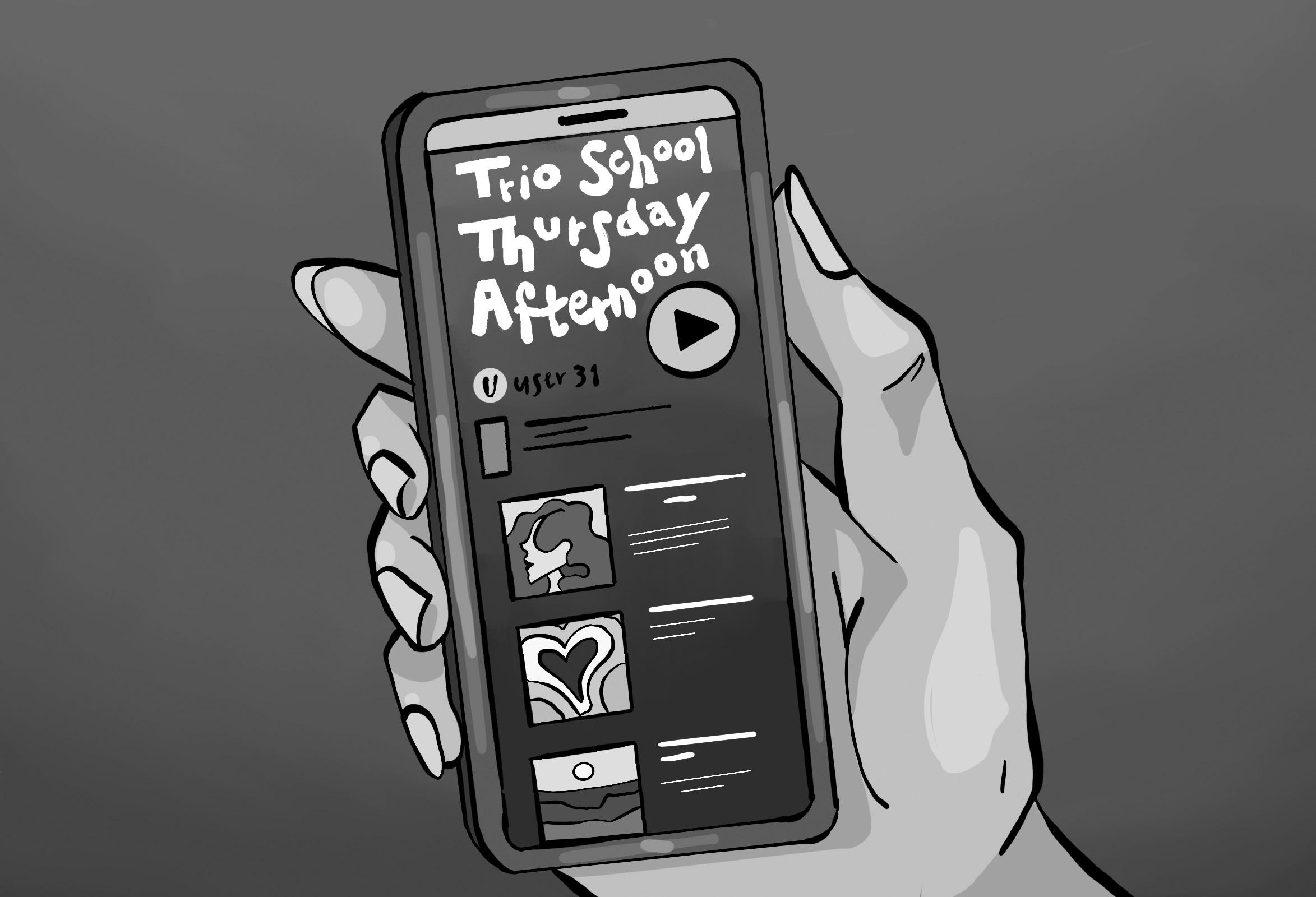
terribly dependent on it. As I’ve grown older, I’ve experienced a rapid decline in my ability to sit with my thoughts in the absence of external stimuli. A walk to class, usually only a 10-minute affair, necessitates that I have my AirPods in. My brain has been rotted away by the shortform content on Instagram and YouTube (thankfully, I never had TikTok because I knew I’d be too far gone afterwards). Put simply, when I don’t want to sit with my thoughts, I put my AirPods in and hit play.
Further, I felt validated by Spotify’s algorithm. Growing up, I’ve always been shy. As a result, I’ve found that people I’m not close with often have grossly generalized assumptions about me. I talk less in situations with people I don’t know well, giving them less material to develop their perception of me around. In their eyes, I am just a shy, anxious bookworm. Even though this is true to a large extent, I still find this perception limiting. It keeps those who’ve only observed me from afar from conceiving of me as someone who could be a jokester, a confidant, a friend.
To suggest that I’m capable of being passionate about things or feel deeply would run counter to the otherwise ironclad perception people who don’t know me well have of me. Still, a large part of this is my fault. I know my public-facing self doesn’t give enough credit to honoring the myriad of thoughts and interests my private self has. In Spotify’s algorithm, I am validated through the algorithmically generated affirmation that my private self persists, in spite of how my public persona undersells who I am. Yes, I’ve never so much as held
hands with anyone, but I still like to dream about having a “spring break situationship monday early morning.” Yes, maybe because I speedwalk everywhere it’s reasonable to assume that I’ve got places to be and I’ve got it all together, when in fact, I’m just as privy to the “crash out stank face friday afternoon” as any other college student is. Yes, I don’t raise my hand enough in class, but I am still afflicted by the all-too-common “relatable scream thursday night” (could my classmates ever imagine me to be this loud?). I’m perpetually single, a hopeless romantic, an on-top-ofit girl, a life-is-falling-apart girl, the classmate in the far corner that never talks and the person who jumps to take the stage at karaoke. And then I’m a million more things.
However, as my Spotify usage has increased, I’ve gotten more accustomed to these daylist titles. In all their desperation for relatability and understanding, the novelty of the daylist has significantly diminished. In fact, it gets my emotions wrong about half of the time. For goodness’ sake, sometimes it’s not a “crying sleepy weepy thursday afternoon,” but a “enthusiastic ballroom disco thursday afternoon.” In these moments where the emotions captured by my daylist title don’t reflect my actual emotions, it seems silly to be placing so much weight on an algorithmically generated string of words. Despite once feeling understood by my daylist titles, it now bothers me.
Maybe I’m reading too much into it. After all, nearly everything in today’s age best succeeds when it makes an attempt at relatability: Marketing campaigns feature trendy celebrities and burgeoning
I’ve debated breaking my vegetarianism or eating meat consistently again many times. I honestly still might occasionally consume meat when I travel or if it’s a special occasion and it feels like I’m missing out on something important by not. But when I think about day-to-day life, two questions ground me in my decision. First, is this something good for a cause I care about that doesn’t significantly detract from my ability to live my life? And second, would I be vegetarian because I feel it’s morally right regardless of whether or not I knew I was making a difference? For me, the answer to both is yes. I don’t have a severe health condition or financial burdens that make vegetarianism something that hinders my life. And it’s something that makes me feel good, regardless of whether or not I am certain that I save 25 chickens a year. As someone who says they stand for environmental causes, I feel strongly that it’s important to align my actions with my beliefs. Abstaining from eating meat is the way I choose to do that so I don’t end up feeling hypocritical of my vote or my criticism of large corporations. If I say I care about the environment, I intend to live a lifestyle that reflects that, the same way I believe that corporations that claim to care about the environment should take meaningful action rather than just transferring the blame onto someone else.
artists release songs that capitalize on my generation’s need for romantic connection in the era of situationships. Even networking, something done in professional settings, is most successful when both people behave as if they’re good friends catching up with one another. Relatability is an asset in today’s age.
Despite this, I think the difference is that daylist tries to maintain its facade of relatability in a place I lean on to feel seen and avoid sitting in the uncomfortable silence of my thoughts. Thus, it seems completely unnecessary for it to pretend to be so friendly when I’ll go to Spotify regardless of whether I’m using the daylist or not.
Looking at it broadly, the titles do vaguely mirror the kind of person I am — fun, loving and perceptive — but these are traits that are widely shared. The titles are easily generalized, no matter how quirky and offbeat they may seem. Moreso, these titles aren’t trying to understand me in the way that my loved ones are trying to. My loved ones will ask me, “How do you feel about this?” and “How do you feel about that?” In all their confused patience, they’re able to deepen their understanding of who I am, fully, as a person. On the other hand, Spotify’s daylist has assumed that it knows me. I don’t even know what I’m fully feeling at a given time, so how could an algorithm know that? In fact, my emotions can be even more complicated and contradictory than what’s given in a daylist title, but I’d never know it if I used the algorithm as a benchmark to measure my feelings against. In fact, I’m much more interesting than the daylist title could ever imagine me to be.
The Michigan women’s golf team looked to cap off a strong fall season with a stellar performance at the Ruth’s Chris Tar Heel Invitational. However, fighting the elements and an uncharacteristic final round, the Wolverines fell short.
Throughout the fall, Michigan consistently coupled a slow start with a recovering finish. In the prior three events, the Wolverines’ lowest score came in the final round. Unfortunately, a thirdround push was not apparent this past weekend as Michigan rounded out the tournament with its highest score on Sunday, shooting 288293-300 over the weekend to finish 10th out of 15.
“This week, we didn’t bring our best overall as a team,” Wolverines coach Jan Dowling said. “There were certainly some great performances and some very nice rounds, but I wouldn’t say we brought it all together.”
Multiple of those great performances for Michigan came in the opening round. Senior Sydney Sung exploded out of the gate, finishing the front nine shooting 2-under-par. While hampered by three bogeys through the back nine, she completed her day leading the Wolverines at 1-over-par (71). And Sung was not alone in her early success.
MEN’S SOCCER

Freshman Reese Ng and redshirt junior Mara Janess also contributed strong rounds of their own, each posting 2-over-par. Senior Lauren Sung’s slow start was salvaged by three consecutive birdies on the back nine to end at 3-over-par.
The team finished the day shooting 288, enough for eighth place out of 15. With a better understanding of the course, Michigan looked to ride its momentum into the rest of the weekend.
Nonetheless, the Wolverines’ success faded fast. On Saturday, the team ran out of gas early. Three Michigan players shot higher in the second round compared to the first, a trend that refused to improve. In a similar fashion, neither did the conditions of the course.
The weather and the layout of the Finley Golf Club, from high winds to deep Bermuda roughs,
managed to play a pivotal role in Michigan’s struggles.
“The weaknesses that we did bring this week were really amplified based on the conditions of the course,” Dowling said. “I mean, it is honestly some of the toughest conditions I’ve seen in college golf, period. I would have said that even before (the third round) with the wind.”
While the Wolverines have consistently found ways to bounce back come round three, the team shot its highest score on Sunday.
Countering previous success, Ng and Janess shot 9- and 10-over par, respectively. While Sydney and Lauren Sung led the way at 3-overpar, the team could not consistently find its footing, burdened by a collective nine double bogeys. Michigan finished in 10th place, the highest finish of the fall.
CONTINUED AT MICHIGANDAILY.COM
SOPHIA LIAO For The Daily
For the first few points of the opening set, the Michigan volleyball team looked steady. The Wolverines passed cleanly, communicated well and even claimed the first two points against No. 1 Nebraska. But once the Cornhuskers found their rhythm, Michigan’s defense simply couldn’t keep up.
It wasn’t that the Wolverines’ defense wasn’t executing, but that Nebraska’s offense dominated at the front line. Michigan entered the night holding opponents to a .195 hitting percentage and averaging more than 12 digs per set. But against the Cornhuskers’ relentless, well-balanced attack, those numbers didn’t hold up. Nebraska hit .390, well above its season average of .330, while Michigan managed just .079, far below its .281 average.
“Nebraska had an excellent and very efficient night,” Wolverines coach Erin Virtue said. “That’s one of the best defenses in the country. They slow a lot down at the net, and they have some really, really good defenders in the backcourt, so kudos to them. But it was also a little bit of our own attacking errors.”
Michigan tried to match that pace, but Nebraska’s offense moved too fast and took advantage of the back row while
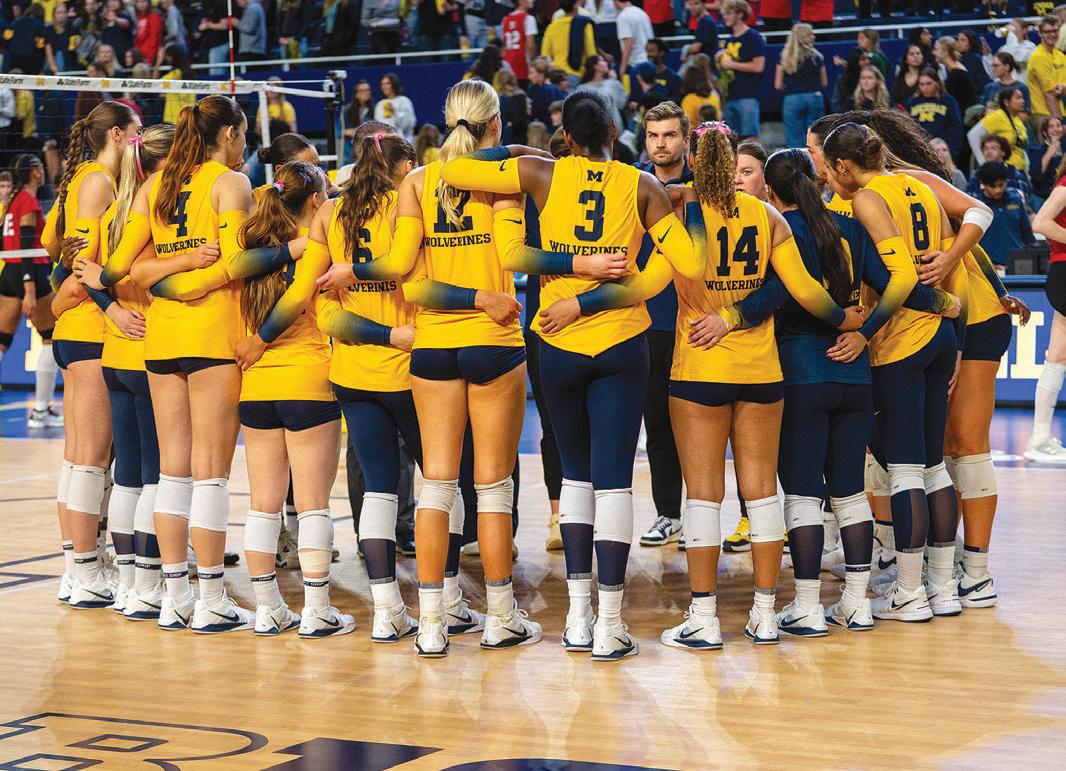
the Wolverines focused on the front line. Nebraska setter Bergen Reilly distributed the ball with near-perfect tempo, stretching Michigan’s block and forcing constant defensive adjustments.
“They were just finding spots on the court that we couldn’t dig,” graduate libero Maddi Cuchran said. “If we can start digging those balls and be able to transition and score, I think we would have caught on a lot faster. But there were plays where balls fell that shouldn’t have fallen.”
By the end of the first set, the Wolverines had already allowed 14 kills and committed eight attack errors of their own. Michigan’s back row, led by Cuchran, often made the initial dig, but Nebraska’s transition offense reset instantly, keeping rallies alive and the Wolverines’ defenders on the move.
Michigan puts pieces together in pivotal home match, securing 3-0 win against
LILA DARWICHE
For The Daily
Coming off a big win against Ohio State last Tuesday, the No. 16 Michigan men’s soccer team had the opportunity to build momentum for the remainder of the season. In Friday’s highly anticipated Big Ten matchup against UCLA, the Wolverines did just that, bringing every bit of their gameplan to fruition, and putting up a relentless fight against the Bruins.
Both UCLA (3-5-3 overall, 3-2-1 Big Ten) and Michigan (8-2-3 overall, 4-2-1 Big Ten) entered the match tied at 10 points in the Big Ten standings. For each of them, this game was especially opportune, but in the end, the Wolverines found success by maintaining their interconnectedness and capitalizing on opportunities as they presented themselves to win, 3-0.
The first half was largely characterized by cohesion from Michigan and panic from UCLA. Right from kickoff, the Bruins flashed potential for a strong offensive push, even managing a shot within
MEN’S SOCCER
the first minute of the game. However, Michigan maintained control through intentional and proactive play, retaliating almost immediately.
“(The players’) approach was exactly as we drew it up,” Michigan coach Chaka Daley said. “It doesn’t always go that way. … But they showed great grit and great character, and they put on an amazing performance.”
The Wolverines moved through the half dominating possession and driving the direction of the game in their favor. Despite the Bruins sharing a similar motivation to find success, they began relying heavily on rushed play, opting for disconnected long balls in a frantic effort to subvert Michigan’s offense.
About halfway through the first half, sophomore forward Michael Ramirez secured the Wolverines’ first goal, assisted by senior midfielder Nicholas Cassiday and junior defender Will Baker. For a moment, UCLA’s motivation seemed revitalized. Just a few minutes later, UCLA midfielder Ander Marticorena sent a ball to the top right corner, but it was
subsequently blocked by junior goalkeeper Isaiah Goldson, immediately switching the play back in the Wolverines’ favor.
With an air of confidence, Michigan capitalized on the Bruins’ jitters and maintained a high press in the midfield. Later in the half, junior midfielder Dylan Davis assisted Ramirez in yet another goal for the Wolverines, and a few minutes later, the half ended with a total of 16 fouls and a growing strain on UCLA’s morale.
“We started off the game really good, especially as a team,” Ramirez said. “We were really going forward, we were attacking the back line and ended up getting two goals because of it.”
The second half saw a shift in possession from Michigan to the Bruins as their defensive line worked on carefully switching the ball and connecting passes with their midfielders in an effort to regain composure. Despite no longer driving the game forward, the Wolverines continued to work cohesively as a strong defensive unit. The team eventually saw a few big goal-scoring opportunities, but Goldson prevented each one from reaching the back of the net, even momentarily injuring himself in the process.
Michigan’s inability to slow the Cornhuskers’ offense was its own struggle from the service line. The Wolverine’s service game couldn’t match Nebraska’s consistency. They showed brief sparks, like when junior setter Morgan Burke subbed in and delivered a fourpoint run including an ace in the third set, but these moments were too inconsistent to disrupt Nebraska’s rhythm. Even Michigan’s defense struggled to contain Nebraska’s quick middle sets, which neutralized the Wolverines’ front line and kept them reactive instead of proactive.
“We were defending at a pretty good level and slowing them down,” Virtue said. “But we needed to be able to get a good attack out of system and slow them down in some kind of way.”
CONTINUED AT MICHIGANDAILY.COM

In the 71st minute, a handball against UCLA allowed for a penalty kick for Michigan. Graduate midfielder Quin Rogers successfully slotted the ball in the bottom right corner, effectively squashing the Bruins’ efforts to flip the game’s result. For the last 19 minutes, the Wolverines’ persistent synergy helped them maintain a strong defensive front and hold UCLA to no additional shots for the rest of the match.
In a match that called for exceptional focus and grit, the Wolverines saw the opportunity to set the pace of the game. By working as a unit and allowing themselves to build on the previous week’s success, they executed exactly what was necessary in order to walk away with a win.
DANNY HUANG For The Daily
The No. 16 Michigan men’s soccer team displayed a dominant offensive performance Friday night. Despite graduate midfielder Quin Rogers scoring for the fifth time this season with a composed penalty kick, it was sophomore forward Michael Ramirez who defined the night. Using his relentless pace, sharp movement and decisiveness in front of the goal, Ramirez set the tone for Michigan’s attack in a convincing 3-0 win against UCLA.
Coming off a long-term injury, Ramirez wasted no time reestablishing himself. After months away, he’s produced three goals and an assist in his last two matches, becoming a pivotal part of the Wolverines’ offense that has scored six goals in their last two games. Friday’s game was no different.
“He was off for an extended time, like six months,” Michigan coach Daley said. “And now, four, five, six weeks in, you can see the fruits of his labor.”
Just 21 minutes into the match, Ramirez received a pass from junior forward Nicholas
Cassiday and wasted no time making his mark. With space, he took a deft touch before curling a deflected shot into the far left corner. Not long after, sophomore midfielder Dylan Davis lofted a cross to the backpost, finding a wide open Ramirez who was able to bury a powerful header for his fifth goal of the season.
“When (Ramirez) is in around the box, he is always a threat,” Daley said. “He’s composed, and shows great calmness.
That’s a big proponent of his game, and he won man of the match tonight as a result.”
Ramirez’s impact throughout
the game went beyond his goalscoring contributions.
Despite playing 80 minutes, the Northwestern transfer constantly fought to win possession and helped Michigan maintain its defensive shape, pressing high and forcing turnovers to keep UCLA on its toes. His hunger to win the ball back for his team was a major reason the Wolverines kept a clean sheet, limiting the Bruins to just two shots on goal throughout the whole game.
Furthermore, his vision and movement allowed him to create opportunities for others, threading precise passes
and making runs that pulled defenders out of position, giving teammates clear looks on goal.
Early in the second half, Ramirez received the ball deep in his own half. Picking his head up, he picked out a perfectly weighted through ball right between the UCLA centerbacks to put junior forward Grayson Elmquist one-on-one with the goalkeeper. Though Michigan was unable to convert the chance, Ramirez’s playmaking elevated the Wolverine’s offense to another level.
“I’m always looking for my teammates and putting them in
the best position possible, just like how they would do it for me.” Ramirez said. As the final whistle blew on Michigan’s 3-0 victory, Ramirez’s impact was undeniable. His two-goal performance against UCLA not only secured three crucial points but also served notice that the Wolverines have found their attacking rhythm when it matters most. Beyond the scoresheet, his energy, defensive contributions and support for teammates highlighted the allaround presence that made him a key figure for Michigan in this Big Ten matchup.


3 MONTHS FREE


